NEWS: HHS Cuts
UChicago Grants for HIV, COVID Research
PAGE 4

APRIL 16, 2025
FOURTH WEEK
VOL. 137, ISSUE 13

NEWS: HHS Cuts
UChicago Grants for HIV, COVID Research
PAGE 4

APRIL 16, 2025
FOURTH WEEK
VOL. 137, ISSUE 13
By ISAIAH GLICK | Senior News Reporter
Seven individuals affiliated with the University of Chicago—three current students and four recent graduates in the U.S. under the Optional Practical Training (OPT) program—were informed on the afternoon of April 9 that their F-1 visas under the Student and Exchange Visitor Program (SEVIS) had been revoked by the federal government.
According to an email from Division of the Arts & Humanities Dean of Students Shea Wolfe reviewed by the Maroon, there is no specific cause known for the revocations aside from “unlawful activity,” but they were not clearly connected to pro-Palestine activities or statements.
The affected individuals became aware of this change only after the University’s Office of International Affairs (OIA) conducted an audit of their records of students on visas; the students were not notified by the U.S. government when the visas were terminated. Currently, the students and graduates are in the U.S. illegally and are
at risk of being deported, but OIA has indicated that they can either speak with an immigration attorney or leave of their own volition.
On April 7, international students at the University received an email from Nick Seamons, the executive director of OIA, stating that OIA will contact international students directly if their SEVIS status is revoked and that they should reach out if they are informed of a termination by the Departments of State or Homeland Security.
Previously, OIA had issued updated guidance to international students and faculty members regarding travel outside of the U.S., informing them that they should take caution when traveling outside of the U.S. and to reconsider nonessential travel.
“Re-entry is not a guarantee [for noncitizens] and [is] at the discretion of the U.S. government,” OIA wrote.
Additionally, OIA urged students to be aware of scammers who might use the threat of deportation to demand money.
“The U.S. government will not call you asking for money in connection with your visa or status. If you receive such a call, please hang up immediately and do not provide any personal information.”
When asked for a statement, the U.S. Department of State referred the Maroon to an April 8 press briefing, where Department Spokesperson Tammy Bruce declined to share any information on why the department had terminated the visas of at least 300 international students nationwide.
“We don’t go into the rationale for what happens with individual visas. What we can tell you is that the department revokes visas every day in order to secure our borders and to keep our community safe, and we’ll continue to do so,” Bruce said.
In a statement, the University told the Maroon it was “committed to continued deep engagement and active exchange with international students, scholars, and visitors. The University has a long history of supporting America’s position as a magnet for talented people from across the globe,
and we will continue to work to assist the members of our international community.”
The University also said that “OIA has offered to connect the affected individuals with immigration attorneys.”
UChicago Faculty Forward, the union representing non-tenure-track faculty, issued a statement criticizing the visa revocations.
“These visa revocations are just the latest in a series of authoritarian, unconstitutional, and unconscionable moves by the Trump White House to target and harass international students and immigrants, colleges and universities, people exercising their rights to freedom of speech, and other groups this administration claims are its enemies,” the statement read.
Faculty Forward urged the University to provide support for affected students, including legal advice and assistance from OIA, along with mounting “a forceful public stand against these authoritarian and chilling actions by the federal government.”
CONTINUED ON PG. 2
By ZACHARY LEITER | Senior News Reporter
UChicago Trustee Antonio Gracias (J.D. ’98) is working at the Social Security Administration (SSA) as a representative of the Trump administration’s Department of Government Efficiency Service (DOGE), per the New York Times.
Gracias is a close friend of Elon Musk, the Tesla and SpaceX executive who now
NEWS: University Introduces New Major in Climate and Sustainable Growth
PAGE 5
serves as a senior advisor to President Donald Trump and a special government employee. Gracias campaigned with Musk in Wisconsin on March 30 at a major rally for Republican state supreme court candidate Brad Schimel.
At the rally, Gracias delivered a presentation on what he called “tremendous
GREY CITY: Reworking A Decades-Old Disciplinary System
PAGE 12
fraud” at SSA, which provides retirement and disability benefits to almost 69 million Americans and accounted for 21 percent of the federal budget in 2024.
Gracias is currently serving his first five-year term on the University of Chicago Board of Trustees, which he joined in 2021. He also serves on the board of UChicago’s Pritzker School of Molecular Engineering.
VIEWPOINTS: AI Professor
Gracias serves as a director at SpaceX and previously served as a director at Tesla from 2007 to 2021. Valor Equity Partners—where Gracias is the founder and CEO—invests in both companies, and much of Gracias’s $2.2 billion personal net worth is held in Tesla stock.
“I have worked closely with Elon for over 20 years,” Gracias wrote on X on
CONTINUED ON PG. 3
ARTS: Maroon Musings PAGE 26
“The seven UChicago-affiliated individuals are among... more than 300 enrolled at various universities who have been informed that their visas had been revoked.”
CONTINUED FROM PG. 1
The seven UChicago-affiliated individuals are among a group of more than 300 enrolled at various universities who have been informed that their visas had been revoked for reasons ranging from traffic infractions to participation in pro-Palestine protests. Affected campuses include private institutions like Harvard University and Stanford University as well as public institutions like the University of Texas at Austin and the University of California system.
On April 8, a representative from the University of Illinois Urbana-Champaign
confirmed to Illinois Public Media News that several of its international students had their visas revoked. Students at Northwestern University and Southern Illinois University have also had their visas revoked in the past week.
Last month, several students, including Mahmoud Khalil at Columbia University, Rümeysa Öztürk at Tufts University, and Momodou Taal at Cornell University, were detained by immigration enforcement or targeted for deportation following their public statements or alleged participation in activism related to the Israel–Hamas war.
Additionally, Citizenship and Immigration Services announced that it would begin monitoring social media feeds for evidence of antisemitic activity as grounds to deny benefit requests to immigrants.
This is a developing story. We ask anyone who has knowledge of visa revocations or other immigration-related issues to please contact us at editor@chicagomaroon.com or to submit a tip through the tip form on our website. The Maroon protects source information, and your name and contact information will only be seen by the paper’s editors-in-chief and managing editor.
Evgenia Anastasakos and Nathaniel Rodwell-Simon contributed reporting.
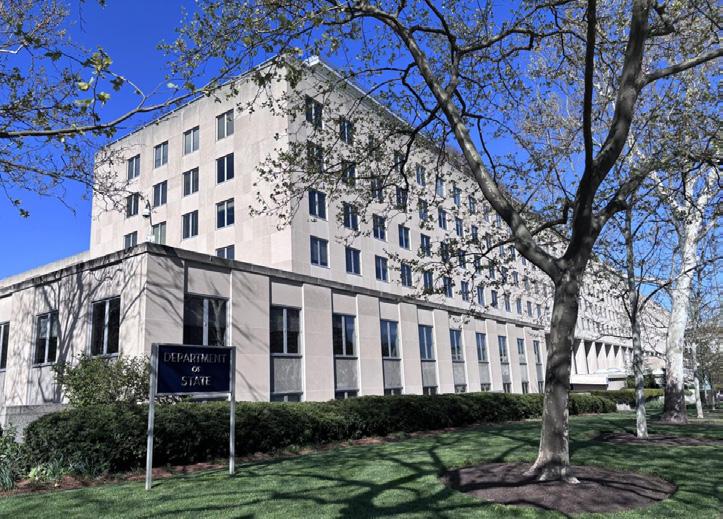
The U.S. Department of State building in Washington, D.C. zachary leiter
By AARYAN KUMAR | Senior News Reporter
The UChicago Office of International Affairs (OIA) updated its international travel guidance following changes to immigration policy by the Trump administration. The new guidelines were announced in an April 4 email from University leadership and through the OIA newsletter.
Interim Dean of Students in the University Mike Hayes and OIA Executive Director Nick Seamons urged noncitizen students, faculty and staff—regardless of their residency status—to take caution when traveling outside of the U.S. and to reconsider nonessential travel. “Re-entry is not a guarantee and [is] at the discretion of the U.S. government,” OIA stated in the travel guidance document.
Several peer institutions, including Brown University and Columbia University, have shared similar statements cautioning noncitizen community members against international travel.
Last month, Secretary of State Marco Rubio confirmed to reporters that he had canceled the visas of more than 300 international students who had joined pro-Palestinian demonstrations. The White House has cited the Immigration and Nationality Act of 1952, which allows the Secretary of
State to deport any noncitizen whose presence or activities the secretary determines have “potentially serious adverse foreign policy consequences for the United States.” Legal scholars have contested the White House’s application of the law.
Prior to international travel, noncitizens should ensure their passports are valid six months into the future and carry proper immigration forms and relevant visa stamps, OIA advised.
According to the updated guidance, international noncitizen travelers should reenter the United States during business hours in Chicago and notify a trusted individual when their flight lands, when they approach customs, and when they are past customs. If the trusted individual is not notified of the final step, the individual should be prepared to contact an immigration attorney and the traveler’s family and have access to a copy of the traveler’s documentation.
OIA also advised individuals on trips “related to official University programs, events, activities, or funded by University resources” to continue registering their travel with UChicago Traveler—the University’s international travel management
portal—so that the “University can provide support in case of emergencies or crises.”
OIA also recommended that travelers be mindful of the content on their devices, which can be subject to search when reentering the United States, and their social media presence. In recent months, Customs and Border Protection (CBP) has used more aggressive tactics to scrutinize visa holders and tourists seeking entry to the United States.
Immigration officials deported Rasha Alawieh, an assistant professor at Brown University and a Lebanese citizen, after CBP discovered “sympathetic photos and videos” on her cell phone taken during the funeral of former Hezbollah leader Hassan Nasrallah.
Philippe Baptiste, France’s minister of higher education and research, alleged that a French researcher was denied entry to the United States over personal opinions the researcher expressed towards President Donald Trump in texts. The Department of Homeland Security has denied this allegation.
In an April 7 follow-up email, OIA warned international students of scammers that may attempt to impersonate federal agents, demanding money and threatening visa cancellation. OIA will
notify any students whose status has been terminated, OIA said.
OIA’s travel guidance document also anticipates further travel restrictions based on an executive order signed by Trump. On March 14, the New York Times reported on a draft travel ban that would ban all entry for citizens of 11 countries, severely limit entry for citizens of 10 others, and force an additional 22 countries to improve vetting or risk a ban.
Thirty-one percent of degree-seeking students at the University are from outside of the U.S., according to the winter quarter 2025 census, though it is unclear what proportion would be directly affected by a travel ban.

1427
“I have been from D.C. to Social Security offices to the border to track [Social Security fraud] down.”
CONTINUED FROM PG. 1
January 23. “His heart is pure, and his sole mission is to help humanity. During the darkest moments, he has shown me the path to choose courage and compassion over fear and hate.”
Both Tesla and SpaceX—and by extension Musk—receive billions of dollars in federal contracts. White House Press Secretary Karoline Leavitt said at a press conference on February 5 that Musk would be trusted with identifying his own conflicts of interest.
Musk’s role at DOGE is unclear. Though media reports often attribute DOGE’s actions to Musk, and though Musk has attended Trump’s cabinet meetings and received Department of Defense briefings, DOGE’s official acting administrator is Amy Gleason.
Gracias’s role in the Trump administration is similarly unclear. Following his arrival at DOGE, Gracias joined the SSA alongside eight other DOGE employees.
In a February 7 interview on the AllIn podcast, co-hosted by Trump A.I. and Crypto Czar David Sacks (J.D. ’98), Gracias characterized his own role at DOGE as being “in and out a little bit and trying to help where I can, but I’m not there full-time.”
During Sunday’s Wisconsin rally, Gracias said, “I have been from D.C. to Social Security offices to the border to track [Social Security fraud] down.”
At the Wisconsin rally, Gracias displayed a graph that purported to show 2 million “New Non-Citizen Social Security Numbers Issued” for 2024. “These are non-citizens that are getting Social Security numbers,” he said. “This literally blew us away. We went [to the SSA] to find fraud and found this by accident.”
“You [only need to] show a medical bill and a school ID” to get a Social Security number, Gracias said. “From there, you get on the voter rolls, and then Dem[ocrat] operatives will farm the vote,” Musk added. While some municipalities have legalized noncitizen voting in local elections, there is no evidence of widespread voting by noncitizens in federal elections.
In meetings with senior staff, SSA Acting Commissioner Leland Dudek has referred to Gracias and other DOGE staff-
ers as “outsiders who are unfamiliar with nuances of SSA programs,” per a March 6 Washington Post article.
Despite DOGE staffers’ lack of experience, “I am receiving decisions that are made without my input. I have to effectuate those decisions,” Dudek told senior SSA staff.
Though the White House said on March 11 that the Trump administration and Elon Musk “will not cut Social Security, Medicare, or Medicaid benefits,” Musk has called Social Security “the biggest Ponzi scheme of all time.”
SSA has faced repeated website crashes, long hold times, and the closure of many regional offices since Trump took office, as the Washington Post reported on March 25.
Neither DOGE nor Gracias could be reached for comment. The White House declined to comment.
When asked whether UChicago’s Board of Trustees was aware of Gracias’s role at DOGE and whether the University had any policies around Trustees’ political activities, a representative of the Board directed the Maroon to a University spokesperson.
A statement from the spokesperson did not confirm whether the Trustees know about Gracias’s role at DOGE. “The Board of Trustees [follow] the responsibilities outlined in the University of Chicago’s governing documents [and adheres] to the University’s conflict of interest policy for Trustees and Officers,” the statement read.
For Gracias, Social Security fraud is part of a broader problem.
On the All-In podcast, Gracias said that he thought more than 10 percent of the federal budget was fraud. “You’re talking about $650 billion, $1 trillion in waste,” he said.
And at the Wisconsin rally, Gracias said that because millions of undocumented immigrants were receiving Social Security, Medicaid, and other federal financial assistance, human trafficking and cartel activity were increasing rapidly.
Undocumented immigrants are generally ineligible for Medicaid and other federal benefit programs despite paying billions in federal taxes.
SSA did not respond to a request for comment.
Gracias has undergone a political transformation in the past decade. He donated to Democratic presidential primary candidates Barack Obama and Hillary Clinton in 2007 and to Obama again in 2012, per Federal Election Commission records reviewed by the Maroon.
He supported Clinton in the 2016 presidential election and gave almost $500,000 to Democratic presidential candidate Joe Biden and the Democratic National Committee in the 2020 election. Both candidates ran against Trump.
In 2022, Gracias donated to Republican Senate candidate Dave McCormick (R-Pa.). In 2024, he donated millions to McCormick, Elon Musk’s pro-Trump America PAC, and the POLARIS National Security PAC, formed to “[h]elp elect conservatives to Congress who will stop
Joe Biden’s dangerous foreign policy and fight for American Greatness.”
However, Gracias also donated in 2024 to the reelection campaigns of Senator Adam Schiff (D-Calif.) and Representative Jim Himes (D-Conn.).
Musk, for his part, contributed $277 million to Trump and other Republican candidates in 2024.
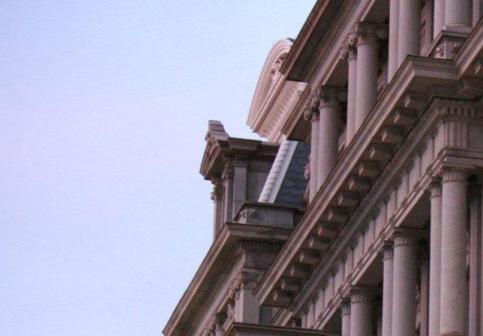
The Eisenhower Executive Office Building, where DOGE is located. zachary leiter


Tiffany Li, editor-in-chief
Elena Eisenstadt, deputy editor-in-chief
Evgenia Anastasakos, managing editor
Haebin Jung, chief production officer
Crystal Li & Chichi Wang, co-chief financial officers
The Maroon Editorial Board consists of the editors-in-chief and select staff of the Maroon
NEWS
Sabrina Chang, head editor
Gabriel Kraemer, editor
Anika Krishnaswamy, editor
Peter Maheras, editor
GREY CITY
Rachel Liu, editor
Celeste Alcalay, editor
Anika Krishnaswamy, editor
VIEWPOINTS
Sofia Cavallone, co-head editor
Cherie Fernandes, co-head editor
Camille Cypher, co-head editor
ARTS
Miki Mukawa, co-head editor
Nolan Shaffer, co-head editor
SPORTS Josh Grossman, editor
Shrivas Raghavan, editor
DATA AND TECHNOLOGY
Nikhil Patel, lead developer
Austin Steinhart, lead developer
PODCASTS
Jake Zucker, co-head editor
William Kimani, co-head editor
CROSSWORDS
Henry Josephson, co-head editor
Pravan Chakravarthy, co-head editor
PHOTO AND VIDEO Nathaniel Rodwell-Simon head editor
DESIGN
Eliot Aguera y Arcas, editor Kaiden Wu, editor
COPY
Coco Liu, chief Maelyn McKay, chief Natalie Earl, chief Abagail Poag, chief
Ananya Sahai, chief
Mazie Witter, chief
Megan Ha, chief
SOCIAL MEDIA
Max Fang, manager
Jayda Hobson, manager
NEWSLETTER
Amy Ma, editor
BUSINESS
Adam Zaidi, co-director of marketing Arav Saksena, co-director of marketing Maria Lua, co-director of operations Patrick Xia, co-director of operations
Executive Slate: editor@chicagomaroon.com
For advertising inquiries, please contact ads@chicagomaroon.com
Circulation: 2,500
By GRACE BEATTY | Senior News Reporter and ISAIAH GLICK | Senior News Reporter
The Department of Health and Human Services (HHS) in March terminated six National Institutes of Health (NIH) grants awarded to University of Chicago researchers, including funding for research into HIV/AIDS, COVID-19, and health inequality.
The UChicago grant terminations, which totaled nearly $6 million, are part of a growing list of terminated research grants awarded to universities, research labs, and public health systems. The move comes as the Trump administration continues to slash government research funding across the country, justifying the actions as eliminating diversity, equity, and inclusion programs and other “wasteful” government spending.
A January 20 executive order titled “Ending Radical And Wasteful Government DEI Programs And Preferencing” directed federal agencies to cancel funds that “provide or advance DEI, DEIA, or ‘environmental justice’ programs, services, or activities.”
A New York Times analysis found hundreds of words that have been “flagged” to be limited or eliminated from federal websites and other government documents. Most of the terms are related to diversity, discrimination, or inequality. According to the Times, federal workers have been told to remove the words and phrases from agency materials and in some cases to “automatically flag for review” any grant proposal containing words inconsistent with the Trump administration’s priorities.
A separate database compiled by Harvard University researchers lists grants terminated by HHS, including words in research proposals that may have been flagged.
In a statement, an NIH spokesperson told the Maroon, “NIH is taking action to terminate research funding that is not aligned with NIH and HHS priorities. We remain dedicated to restoring our agency to its tradition of upholding gold-standard, evidence-based science.”
“As we begin to Make America Healthy Again, it’s important to prioritize research that directly affects the health of Americans,” the statement read.
The NIH did not provide an explana-
tion for why individual grants were terminated or how the affected grants were inconsistent with NIH and HHS priorities to the Maroon
John Schneider, a professor of medicine and public health sciences at UChicago, is the principal investigator (PI) on a study retrospectively examining the increased risk of COVID-19 transmission and decreased access to testing and vaccination among migrant workers. Schneider’s team was initially awarded $374,670 by the NIH in March 2024, of which the remaining $99,409 was revoked on March 10, 2025.
Schneider told the Maroon that his study was unrelated to the HHS’s stated reason for its cancellation: that his research was ostensibly nonscientific and focused on diversity.
“We looked at the entire grant proposal and there was no mention of diversity throughout the entire research plan,” he said.
A grant termination letter reviewed by the Maroon informed the affected researcher, “It is the policy of NIH not to further prioritize research programs based primarily on artificial and non-scientific categories, including amorphous equity objectives, are antithetical to the scientific inquiry, do nothing to expand our knowledge of living systems, provide low returns on investment, and ultimately do not enhance health, lengthen life, or reduce illness.”
“Worse, so-called diversity, equity, and inclusion (‘DEI’) studies are often used to support unlawful discrimination on the basis of race and other protected characteristics, which harms the health of Americans. Therefore, this project is terminated,” the letter concluded.
Schneider is also the PI of a study looking into the relationship between cannabis use and HIV “acquisition, testing, and care” for young Black men. Initially awarded $2,814,152, HHS terminated nearly $400,000 in outstanding funding.
“We’re in year three of five… This is a multi-million-dollar grant,” Schneider said. “We’ve already spent about half of it, and so if we can’t complete it, that’s… wasted money, it’s wasted time, it’s wasted effort.”
Schneider intends to appeal the deci-
sion: “I know there are some great people who have appealed so far and have been successful, [but] I’m sure there’s a lot who have appealed and have not been successful.”
A coalition of public health groups, unions, and individual researchers filed suit against the NIH, HHS, and their respective agency heads on April 2 seeking to restore terminated research funding. Separately, 23 state attorneys general have also sued HHS and HHS Secretary Robert F. Kennedy Jr. to have public health grants to their states restored.
A federal judge has since granted a temporary restraining order (TRO) in the states’ lawsuit.
In a statement, a University spokesperson told the Maroon, “The University of Chicago is dedicated to supporting our researcher community and the impactful, field-defining research produced across all academic disciplines. The Office of the Provost is working to help researchers identify potential alternative research funding sources where possible.”
Associate professor of medicine Jessica Ridgway, another PI whose study faces a grant cancellation, told the Maroon, “We have patients who were actively receiving care for their substance use, and we had to call them and tell them that we were not able to provide that care anymore and help try to find them alternative resources or places to go for their substance use treatment.”
Ridgway is the PI for a study looking into the overlapping challenges between substance use disorder (SUD) and HIV care among Black Americans, analyzing inadequate access to healthcare, stigma, and lack of engagement with care.
Her team aims to design and implement
a strategy to increase portal engagement, perform a trial to assess the effectiveness of clinic visits, and ultimately improve SUD screening and treatment among Black people living with HIV. HHS has revoked the remaining $758,813 of Ridgway’s $1.5 million grant.
Previously, on February 7, the NIH instituted a 15 percent cap on the “indirect costs” of research, which include administrative functions, maintenance costs, and utilities of buildings, for federal research grants.
After 22 state attorneys general sued the NIH to block the indirect funding cap, a federal judge issued a TRO on February 12 to prevent the cap from taking effect. UChicago concurrently filed a lawsuit with 12 other universities and several academic organizations, which also resulted in a TRO.
In a February 11 letter to UChicago faculty explaining the decision to sign on to the lawsuit, University President Paul Alivasatos wrote that the “precipitous timing of [the indirect funding cut] would immediately damage the ability of our faculty, students, and staff (and those of other academic institutions and medical centers across the nation) to engage in health-related fundamental research and to discover life-saving therapies.”
“I do think that we will find a way through this and past these funding cuts,” Ridgway said. “I think that you know people in the community and researchers that focus on people living with HIV are particularly resilient and are banding together. I think we’ll hopefully find… a way through. It is painful and disappointing right now.”
Nathaniel Rodwell-Simon contributed reporting.
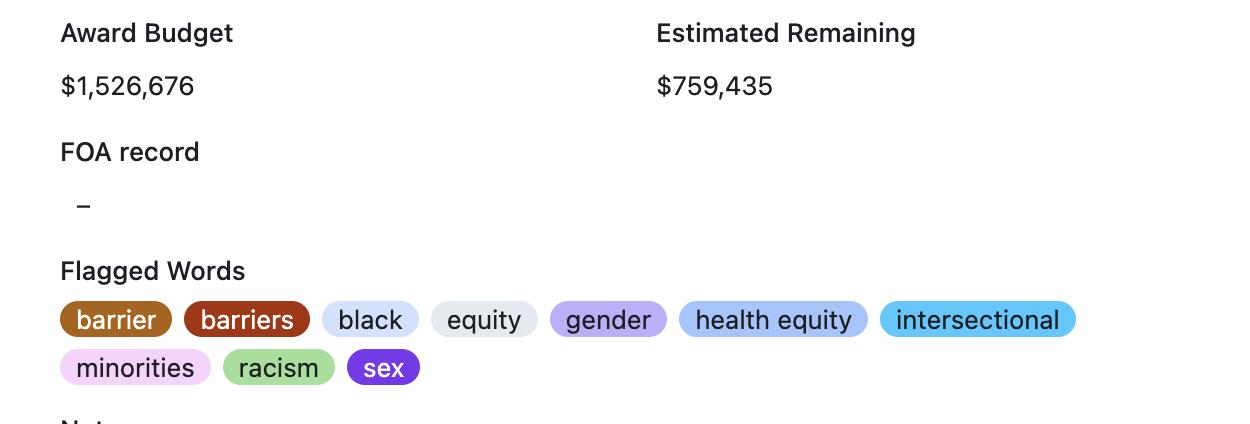
A screenshot of the database’s entry for associate professor Jessica Ridgway’s cancelled grant for research into the relationship between substance use disorder and HIV care for Black men. nathaniel rodwell-simon.
By ELIOT AGUERA Y ARCAS | News Reporter
The Institute for Climate and Sustainable Growth will introduce a new interdisciplinary undergraduate major and minor in Climate and Sustainable Growth beginning in fall quarter 2025. Housed in the Physical Sciences Collegiate Division, the program will give students a climate-oriented foundation in economics, policy, and energy technologies.
After a sequence of seven foundational courses, students will have the option to choose between three specializations: Climate Science and Technology; Politics, Economics, and Society; or Finance.
The major owes its formulation to the same 2023 report that led to the launch of the Institute itself in October 2024. The report was composed by a faculty committee, chaired by Milton Friedman Distinguished Service Professor in Economics Michael Greenstone, tasked with assessing the University’s interests and obligations in the climate space. The report laid out a broad program to promote climate research and reduce institutional emissions. Greenstone now serves as the Institute’s founding director.
In his initial announcement of the Institute, University President Paul Alivisatos promised that “a number of education-based initiatives and programs will be developed to cut across many disciplines and research topics.”
The major has been in development for two years, answering what Greenstone described as “an insatiable demand” for new curricula on climate. In recent years, the University has seen an increasing number of majors in climate-related fields.
In the Division of Social Sciences, the Committee on Environment, Geography, and Urbanization (CEGU) began offering both a major and minor of the same name
in the fall of 2023, replacing the Environmental and Urban Studies major. Students majoring in public policy also have the opportunity to specialize in energy and environmental policy.
Universities around the country have similarly expanded their climate offerings. Vanderbilt University’s Climate Studies major, launched in 2022, aims to integrate coursework in the humanities and social sciences. The Columbia Climate School at Columbia University recently introduced master’s programs in Climate and Climate Finance, as well as Climate and Society.
The Climate and Sustainable Growth major proposes to take a holistic approach to climate that students might not find in a traditional curriculum. “We definitely have environmental science majors and lots of classes in law and policy fields focused on the area, but this brings all of those things together,” said Vaani Kapoor, a second-year in the College and member of the Energy and Climate Club.
Second-year Iris Badezet-Delory, a co-president of the club, explained the case for an interdisciplinary approach: “If you’re working on a technology that you think could help with the adaptation or mitigation aspect, great, but if you don’t know how to sell it to businessmen and show why it’s amazing, people are not going to invest in that.”
“If you’re not able to see the possible policy outcomes of your technology,” she continued, “it might not be widely adopted. If you’re working in finance, you’ve got to take both policy and tech considerations into mind when you’re making an investment decision. Same with public policy. Those three arenas really interconnect when you’re talking about climate and energy.”
The major will also offer opportunities to study abroad through a selection of September Term experiential courses intended to bring global perspectives into the curriculum.
Students travelling to destinations in rural India and sub-Saharan Africa will gain insight into how people live with relatively low levels of energy consumption, while others will spend the term in West Texas, where the booming oil and gas economy relies on fracking. Other groups visiting Wall Street or Washington, D.C. will have the opportunity to meet the investors and policymakers who shape decision-making surrounding climate.
In an interview with the Maroon, Greenstone said that he looks forward to students bringing the diverse understandings these experiences will provide back to the classroom. “Each of those groups are going to have very different perspectives, and what we want is students… to be able to hold those multiple competing perspectives in their head at once and try to make sense of them,” Greenstone said. “That’s what education is supposed to be. You take a bunch of complicated ideas, some of which seem to run in opposition to each other, and how do you make sense of them? How do you draw conclusions?”
Greenstone hopes that UChicago’s Climate and Sustainable Growth major will serve as a template for other institutions. “Just as the Chicago Principles for Free Expression have proved to be very influential in higher ed [and] in the world broadly, we aim for the same thing for the Chicago curriculum,” he said.
The major’s creators aim for students to emerge from the Climate and Sustainable Growth program well equipped to enter a growing niche for sustainability specialists in both the private and public sectors. Within the past five years, job prospects in
corporate sustainability have been among the fastest growing in the country, with few candidates well-trained to step into those roles, Greenstone said.
Kapoor also highlighted the major’s pathway to more specialized career areas. “It’s going to create so many more opportunities for students… to get exposure to the field and matriculate out into working in the climate space rather than just general policy or general business areas,” she said.
At the same time, Greenstone emphasized the value of the curriculum in its own right as part of a broad liberal arts education, a priority which informed its development. “The University of Chicago is not a technical school, in that the deepest aim of education is to help students learn how to learn.… By taking this multi-dimensional, multi-faceted problem and getting people to develop the muscles in their brain to be able to see this problem in all of its glory and all of its complexity and reach conclusions for what they think is the right thing—that ‘learning how to learn’ is something that time will never take away.”
In the coming years, Greenstone anticipates the curriculum adapting not only as a result of student input but also as the field itself is reshaped by developing research. “We’re in the second or third inning of the climate challenge. It’s not going away,” he said. “There are projected to be high levels of CO2 emissions out into the indefinite future. In its own way, unfortunately, climate change is a growth business.”
Beyond the new major and minor, the Institute also hopes to apply the curriculum for a master’s program through the Harris School of Public Policy. The program would become available for the 2026–27 academic year.
Student information sessions about the major are slated to take place in spring 2025.
By NATALIE EARL | Staff Photographer
cultural show on Saturday, March 29, at 8 p.m. in Mandel
The show was ac-
companied by an art display outside the hall that showcased SASA members’ visual art, poetry, and photography. Pagal Khaana: House of Madness,
a short film SASA produced, played in segments between each performance and guided the audience through the experi-
“The almost two-and-a-half hour show was high energy from beginning to end.”
CONTINUED FROM PG. 5
ence of high school senior Anush (Vivek Cherian) as he struggled to embrace his family and culture. Heartfelt and witty, the film left the audience with the message that there is much to be gained through deepening our bonds with family and friends and, ultimately, culture.
Directed by Antrita Manduva, Raghav Pardasani, and Ishi Sood, the almost two-and-a-half-hour show was high energy from beginning to end, keeping the audience excited and often whooping in encouragement, laughing, or clapping along.
The official show program is quoted throughout for an accurate description of each performance.
See chicagomaroon.com for the color version of this photo essay.
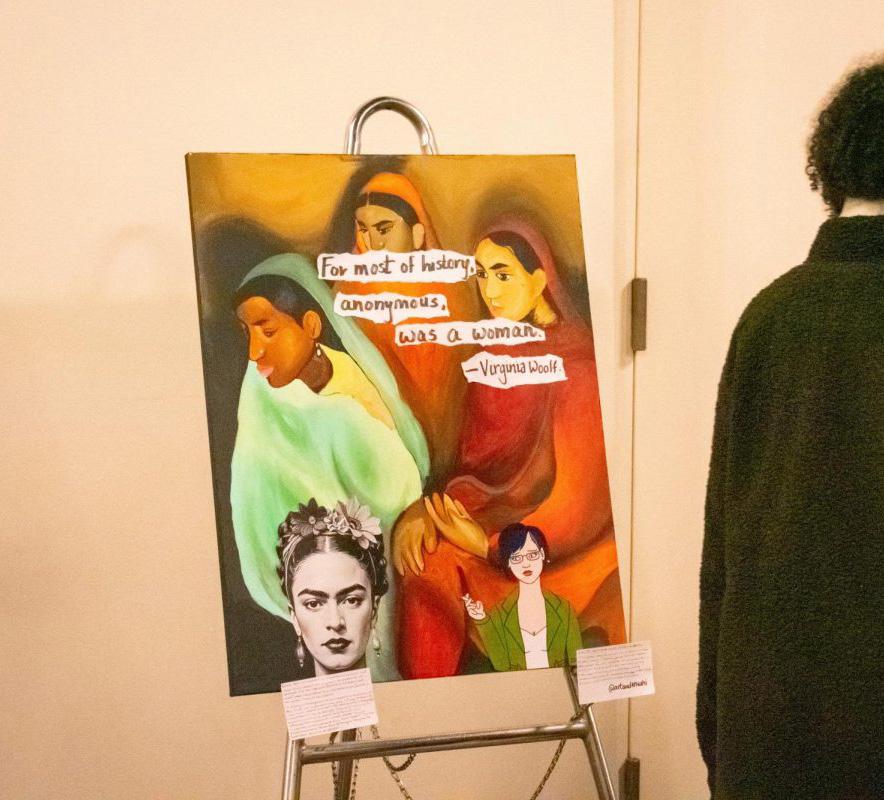
SASA members’ artworks—largely focused on their cultural experiences—are displayed gallery-style outside Mandel Hall for attendees to view. natalie earl
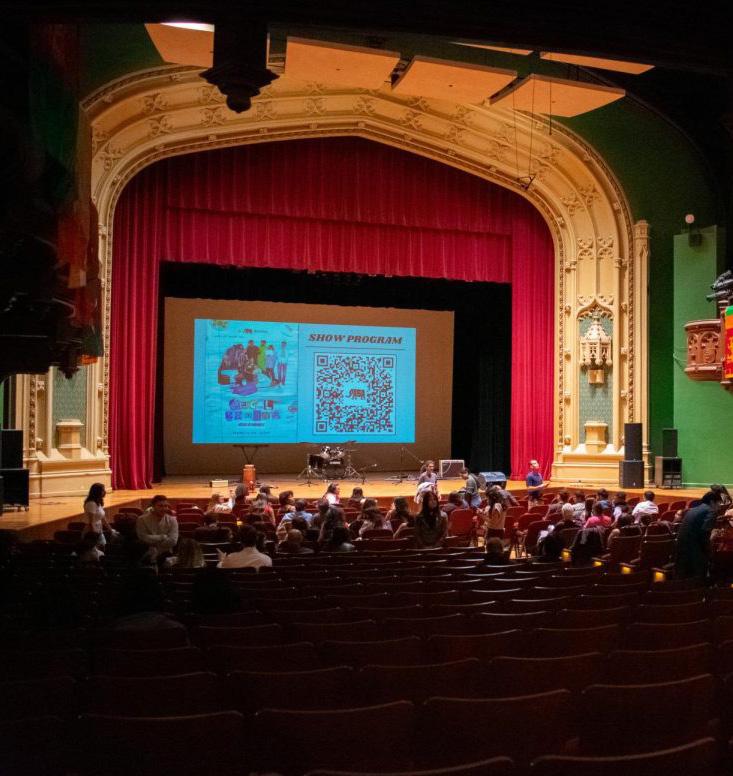
Audience members file into Mandel Hall to find their seats for a sold-out show, with SASA reporting over 720 tickets sold.natalie earl .
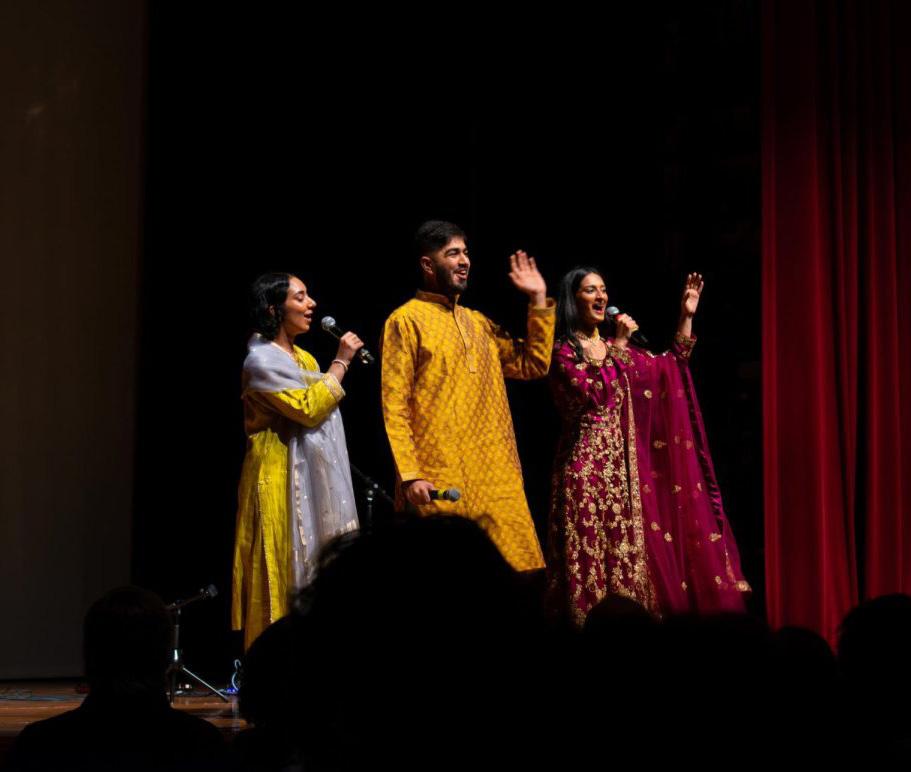
Raghav Pardasani (center), and Antrita Manduva (right) welcome the audience and open the show. natalie earl
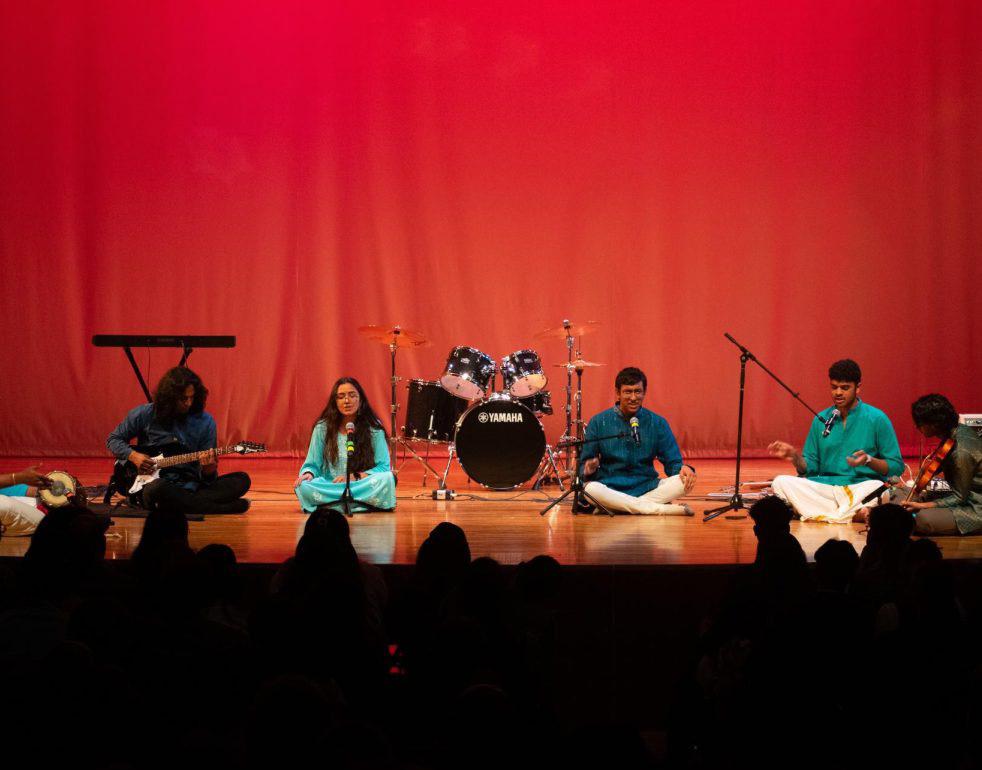
The first performers of the night, from left to right, Harsha Mandayam Bharathi (mridangam), Sammy Thiagarajan (guitar), Parjanya Tiwari (vocals), Anuraag Kaashyap (vocals), Rishabh Subramanian (vocals), and Pravan Chakravarthy (violin), bring the audience “classical music from across South Asia, including Carnatic, Hindustani, and sub-styles within these genres.” natalie earl.

Rock band AC/Desi wows the crowd with a performance of South Asian pop and rock songs. The group is composed of Amam Jain (vocals), Mridvi Khetan (vocals), Sammy Thiagarajan (guitar), Tia Khosla (keyboard), Hetav Mehta (guitar), Avyay Duggirala (bass), and Ayush Gautham (drums). natalie earl .
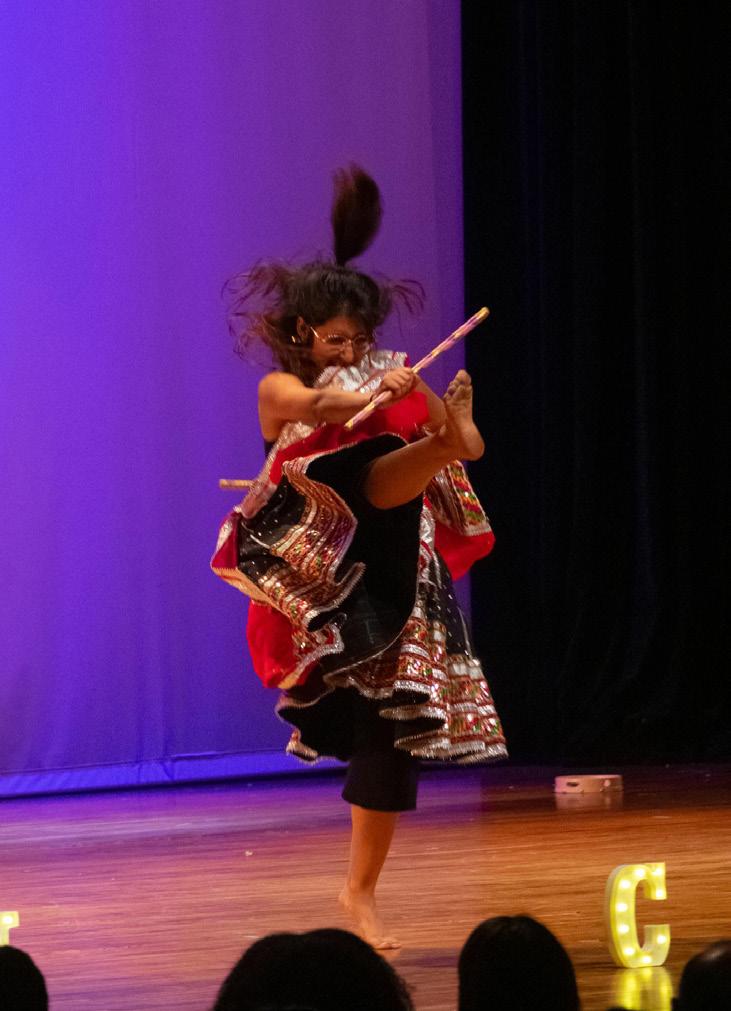
SASA members bring high energy to their Garba and Raas performance—traditional folk dances from Gujarat—choreographed by the Chicago Raas team. natalie earl
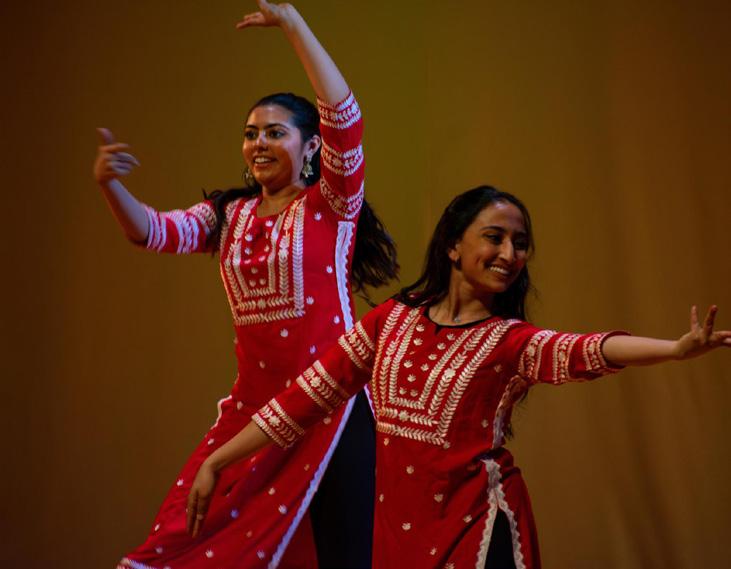
SASA members perform a dance choreographed by Apsara, “combin[ing] classical forms of dance—Bharatanatyam, Kathak and Kuchipudi—with Fusion music, such as Bollywood, Rap or classical South Indian.” natalie earl
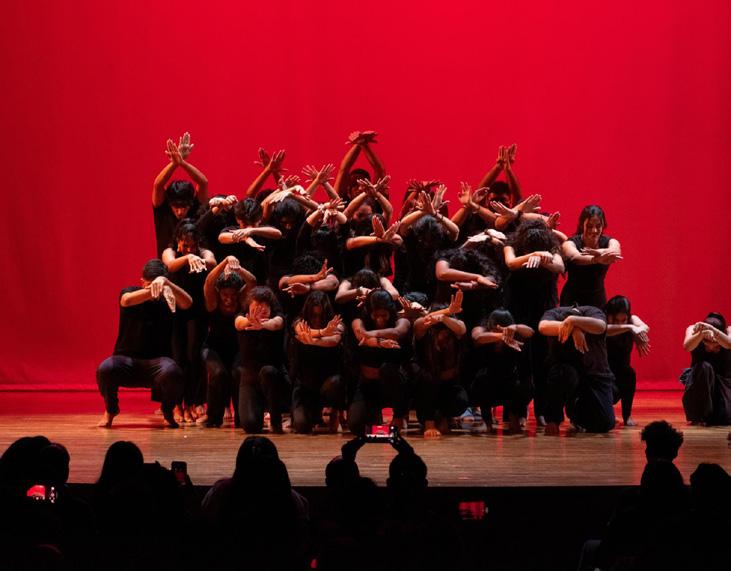
SASA members leave the audience in a frenzy with their fusion dance, a “lively performance with dance styles and music from around South Asia.” natalie earl .
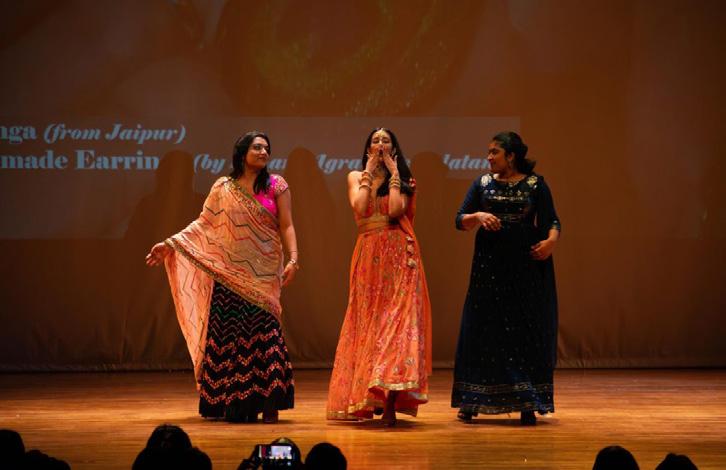
SASA members strut down the runway to display the diverse fashion and jewelry of South Asia. natalie earl .

Chicago Aag performs a cappella medleys of popular South Asian and American songs. The group is composed of Anuraag Kaashyap, Trayi Ajit, Eden Anne Bauer, Saumya Gondotra, Aanya Bhola, Rishabh Subramanian, Neel Maheshwari, Arnav Modak, Ishaan Goel, Grey Singh, Aria Saxena, and Parjanya Tiwari. natalie earl .

UChicago Bhangra performs Bhangra, “a folk dance, originally from Punjab, full of high energy and fast movements.” natalie earl
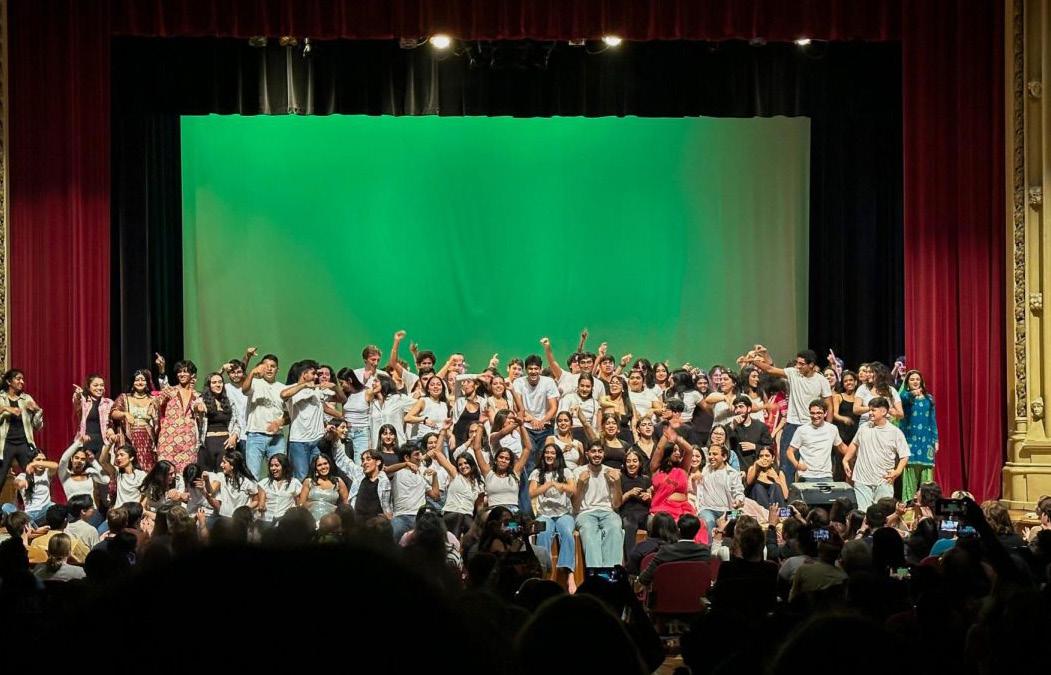
Class of 2025 SASA members—dressed in blue jeans and white tees—take up the stage in the final photo of the night. natalie earl.
By GABRIEL KRAEMER | News Editor
Heidi Heitkamp, the outgoing director of the Institute of Politics (IOP), sat down with the Maroon last month to discuss her tenure as director, challenges the IOP faces going forward, and her future plans.
The former U.S. senator has led the IOP since January 2023. The IOP announced in January that Heitkamp will step down later this year following a “global search” for her replacement. She will stay on as a member of the IOP’s board of advisors after her departure.
This interview has been lightly edited for length and clarity.
Chicago Maroon (CM): What do you see as your major accomplishments as IOP director?
Heidi Heitkamp (HH): In this transition between a founder—David [Axelrod]—and thinking broadly about what the next 10 years of the IOP look like, I think we set it on a good trajectory. The one thing that I would say that I’m probably most proud of is I think we’ve increased the collaboration across programs…. Before I came here, the place was pretty siloed. By that I mean, civic engagement did their thing, career development did their thing, speakers did their thing, [Pritzker] Fellows did their thing.
What we’ve really tried to do with the staff is say, “Look, we’re student-facing.” We have to look at a student who is thinking: “I want to be an ambassador for a fellow who works in climate.” How can we help that same student find an internship in climate? How can we find an opportunity for them to engage in the community in a way that helps them build their climate resume? So to me, [one of my major accomplishments at the IOP has been] the collaboration across the various groups that we operate.
The second thing is broadening the scope of [the IOP’s] Bridging the Divide [initiative]. As we have seen more and more political discourse becoming very siloed, very, very rancorous, [we aim] to try and figure out how we can engage students in ways that give them the skills to engage in respectful dialogue. And so
[with] Bridging the Divide, we did our big conference on urban–rural [division]. Now, with [the] Divided We Stand [initiative], we’re looking not just at urban-rural divisions but gender divisions, cultural divisions, religious divisions.
David [Axelrod] ran Bridging the Divide, but it was a much more contained program. It involved taking 15 students and having them engage across with other universities, other campuses. My feeling was that those 15 students could have gotten a great advantage, but in this time of polarization… broadening Bridging the Divide is responsive to the times we’re in.
A lot of this, to be fair, has been driven by our student advisory groups. My goal coming here was to maintain, if not increase, student-facing reaction. By that I mean the ability of students to come here and say, “This is more of what we need from the IOP.” We’ve always been student-facing, but I think we’ve really tried to make it much more about our students.
CM: The University’s financial issues have been under the spotlight for much of your time as director. How have those concerns affected programming at the IOP, if at all?
HH: This has been a difficult time because of the University budget concerns.… We haven’t been able to hire because of] the hiring freeze, [so] people have been doing double time. We used to do a lot of programming that involved students being able to get subsidized trips; I don’t think we’re as robust [as we used to be] in that area.
The one thing that I would say that I have refused to do, that I think other programs have, is eliminate any of our internships. I think there’s some programs that have gotten rid of their academic-year internships—it means that our applications tripled. And so, to me, [eliminating internships] is a nonstarter.
CM: How do you see the Trump administration’s cuts to the federal government affecting the IOP and similar institutions at other universities?
HH: There’s been plenty of students who want to work in this administration. But we’re seeing more students wanting
to have an internship experience that is outside of government, and I think that’s good. Looking at state and local [government] is an important recalibration, because I think way too often students think that the only experience that’s worthwhile is in Washington, D.C., and I disagree with that. If I compared my internship in D.C. that I did when I was a junior in college with my internship at the North Dakota legislature, the North Dakota legislature had a much greater impact on how I thought about my role. I ended up being a state official, and I’m not sure I would have done that without that experience in the state legislature.
So what I would say is that it has now broadened our thinking about how we do more hometown internships, which is a favorite program of mine. How do we be responsive in the moment? And then how do we become a place for dialogue for students who are concerned?… There’s just a lot of students on campus who haven’t been all that interested in politics and now are approaching our student leaders because all of a sudden they’re not going to get into a Ph.D. program because [the National Institutes of Health’s] money has dried up. And so, I think it’s a real opportunity to bring non-traditional students to the IOP who now realize the impact of government decisions on a much broader swath of America.
So, we’re looking for the opportunities: the opportunities to build state and local leadership experiences, internship experiences; the opportunity to have programming for students who would not otherwise have an interest in politics that now are saying, “Whoa whoa whoa, I guess this could affect me”; and an opportunity for reflection for a lot of students on how this vote happened.
And then one thing that we’re deeply concerned about is the future of science. That’s one thing I’m very excited about and will stay engaged and involved in, which is this political intersection between science and scientific discovery and politics. That’s a role we can play at a university that’s a major research university.
CM: Could you talk a bit about what happened during pro-Palestine protesters’ occupation of the IOP last year?
HH: I was right here, actually, doing
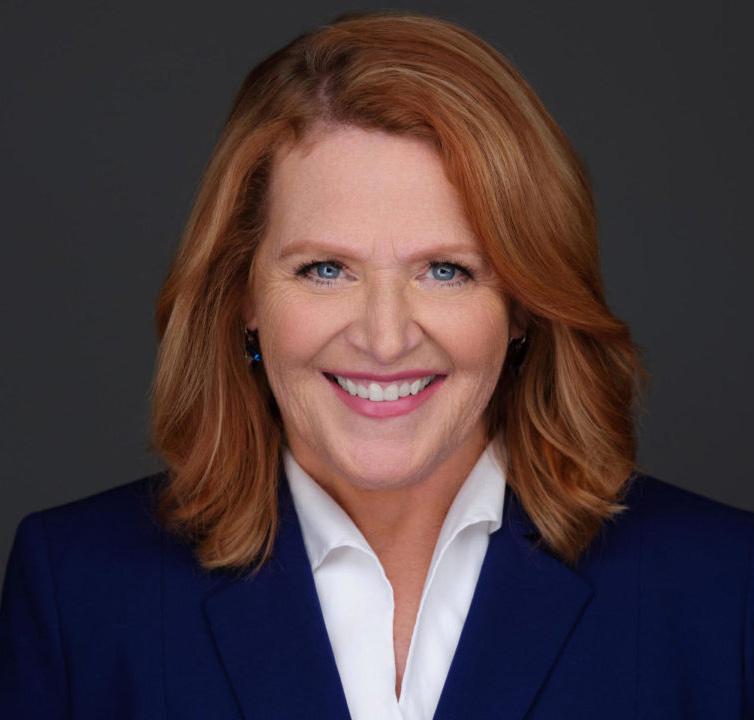
Heidi Heitkamp began her tenure as IOP director on January 3, 2023. courtesy of s christopher gillett
a hit with ABC. I’m an ABC contributor. I wasn’t on air yet—I was waiting to go on air. And the door burst open because I always keep the door shut when I’m doing this. I had heard the protesters come down.… I thought, maybe they’ll move on so that background noise won’t be there. And all of a sudden, the door burst open, and three masked protesters came in the door. The first thing they said is, “You have to leave.” They clearly did not want me in this building. And I said, “No, I don’t think I do.” And then in the meantime, ABC is like, “What’s going on?” So I kept saying, “Just let me do the ABC hit. Let me do the ABC hit, and we can talk about this.” And they were not having any of that.
Eventually I just said, “I’m not leaving.” And they said, “Well, you know, you’re going to get hurt.” And I said, “Who’s going to hurt me?” It was not well thought out on their part in terms of how they were going to occupy this building. The only time that I got irritated is when I heard them throwing furniture because I thought, “You don’t need to do that.”
But we had a great conversation about why they were in this building. I never really did understand [why], and I wanted to say, this is a place where— well, I wouldn’t say it’s First Amendment hallowed ground; that’s a little grandiose—but it is a place where we want to be respectful of all opinions. And it was our feeling that, to maintain that obligation we have on this campus, we can’t just simply capitulate; we have to engage.
CONTINUED ON PG. 8
“We... want to expose students to a whole different way of thinking about how they can engage civically, rather than just traditional political engagement.”
CONTINUED FROM PG. 7
And so that’s what happened. Eventually, after 20, 30 minutes, that’s when the police came in, and the [protesters] jumped out the window.
I like to think that, as somebody who is here as a steward of the ideals of the IOP, that that was a period in time where we reflected those ideas. Let’s engage in dialogue, respectful dialogue.
CM: Looking back at your tenure at the IOP, is there anything you wish you had done differently as director?
HH: I wish I had more time. And, you know, that was self-imposed. I made a three-year commitment and knew that I really could not take any more time away from my family. And so, you know, it always takes you about a year to get your feet underneath you and another year to get people to trust you, and so I feel like we’re kind of hitting on all cylinders. But when I leave here, I’ll go on to the advisory board—I mean, I’m not really leaving the IOP in terms of thought participation on what this [institution] should be.
I’m trying to think of regrets. I mean, I am somebody who does a lot of evaluation at the moment, right? So if I think I’m not articulating or not doing enough with students, I’ll try and correct that. This has been a journey of, what can we
do differently? How are we going to respond to students who have legitimate concerns about whether we’ve been responsive to their issues? How can we do better?… If I had to leave with one goal, I would say expanding the internship programs would be a huge goal. I once told [a group of College parents that] my goal for the IOP would be that every student who qualified and wanted an internship could get one. And I don’t think we’re there.
CM: You spoke about budgetary issues a bit earlier. What do you see as the biggest challenges for the IOP going forward, after you leave this role?
HH: Funding—to fully fund all the things that we should be doing here on campus, especially expanding our internship program and our civic engagement. I think we do a great job with speakers. I think we do a great job with Fellows, thanks to the Pritzker family. We have what we can manage there.… I think the next IOP director is going to have to be very forward-facing on funding challenges and fundraising.
[And] continuing to build out student engagement. Listening to students. To me, a fellowship is successful when I hear a fellow say, “My favorite part is office hours. I love the kids”—I had someone tell me that reason. And I just think,
“Now I’m glad we picked you because you get it, you get why we’re here,” which is to expose people [to nontraditional figures with] the Pritzker Fellow program, to not just have more traditional former elected officials. Even if you’re picking former elected officials like Jon Tester, Jon Tester’s been teaching people a lot about farming, about nutrition, and that’s something that students wouldn’t otherwise [learn about].
Obviously, Pete [Buttigieg] is a fan favorite, but you know, he’s not really saying anything different than what he says every day. That’s valuable for students, and I’m grateful that he has accepted the opportunity. But we also want to expose students to a whole different way of thinking about how they can engage civically, rather than just traditional political engagement. We want to maintain that responsibility, but we also want to say, “You can do it through art, you can do it through music, you can do it through your religion—you know, how does that work? As a scientist, what do you need to do to be engaged?”
CM: What is next for you? What do you plan to do after you step down from the director role?
HH: I have a lot of obligations and responsibilities beyond the IOP. Because I
knew that this was time-limited, I didn’t really cut back on a lot of my nonprofit work [or] civic engagement. I’ve been very involved in pro-democracy work since I left the Senate. So for me, what this will do is give me more time with my husband and my new grandbaby. It’s almost cliché, “Oh, I’m leaving to spend more time with my family.” But I’m turning 70 this year, and so for me, that was kind of a pivotal point of, you have maybe, God willing, another 10 years of runway. How are you going to use it?
Like I said, that will include staying very involved in the IOP. They may want me to come back and moderate a program; they may want me to come back and do a student engagement [program]. I’m [still] going to be engaged here at the University of Chicago, even though I won’t be the director of the IOP.
CM: Has there been any progress on the search to find a new director?
HH: It’s very robust. We’re just very grateful that there’s been so many really great candidates who have stepped forward. We continue to work with the University, because obviously the University will be part of that process, the president and the provost, but we’re excited about the depth and the experiences of the applicants.
By KATHERINE WEAVER | News Editor
A judge for the U.S. District Court for the Northern District of Illinois dismissed a Securities and Exchange Commission (SEC) case against a unit of University Trustee Don Wilson’s (A.B. ’88) Chicago-based crypto trading firm Cumberland DRW on March 31. The SEC and Cumberland DRW jointly sought the dismissal.
In a March 27 press release, the SEC said its decision to drop the case “rests on its judgment that the dismissal will facilitate the Commission’s ongoing efforts to reform and renew its regulatory approach to the crypto industry, not on any assessment of the merits of the claims alleged in

the action.”
The Biden administration greatly expanded cryptocurrency regulation under the leadership of then SEC Chair Gary Gensler, especially after the collapse of digital currency exchange platform FTX in 2022. Shortly after returning to the White House, the Trump administration began scaling back enforcement efforts against cryptocurrency firms, leading to the abandonment of a series of lawsuits from the last few years against firms such as Coinbase.
According to Crain’s Chicago Business, the SEC’s case against Cumberland DRW was a “holdover from the tail end of the Biden administration’s SEC,” and many similar lawsuits had already been dropped.
In a press release on October 10, 2024, the SEC announced that it had charged Cumberland DRW with violating federal registration laws for selling more than $2 billion of cryptocurrency assets as securities. The statement alleged that the unregistered dealings had been going on since at least March 2018.
Cumberland DRW claimed in a separate October 10 statement posted on X that the SEC had made several errors in both the communication and enforcement of Biden-era registration law changes. “Today’s complaint is the first time the SEC has outlined the specific transactions at issue,” the statement read. “The SEC asserts these
“We look forward to continuing our dialogue with the SEC to help shape a future where technological advancements and regulatory clarity go hand in hand.”
CONTINUED FROM PG. 8
transactions required us to register as a broker-dealer. While we strongly disagree, we took that step and acquired a registered broker-dealer in 2019. Only then… were we told we could only use our broker-dealer to trade [Bitcoin] or [Etherium] (both commodities and not under the jurisdiction of the SEC).”
In an interview two weeks later with CoinDesk, a cryptocurrency-focused
news website, Wilson claimed that the SEC’s guidelines for cryptocurrency firm registration are unclear by design: “This dynamic put the SEC in a position where they could say everyone is breaking the rule, and we’re just going to go after whoever we want to.”
President Donald Trump ran on a platform of being friendlier to the cryptocurrency industry than the Biden administration. In March, Trump signed an executive
order to establish both a Strategic Bitcoin Reserve and a U.S. Digital Asset Stockpile to capitalize on Bitcoin and other digital assets owned by or forfeited to the Department of the Treasury.
“The Executive Order begins to resolve the current disjointed handling of cryptocurrencies seized through forfeiture by, and scattered across, various Federal agencies,” the fact sheet on the order read.
“As a firm deeply committed to the
principles of integrity and transparency, we look forward to continuing our dialogue with the SEC to help shape a future where technological advancements and regulatory clarity go hand in hand, ensuring that the U.S. remains at the forefront of global financial innovation,” Cumberland DRW wrote in a statement on X announcing the joint filing to dismiss the case.
Aaryan Kumar contributed reporting.
By KALYNA VICKERS | Senior News Reporter
The inaugural Chicago Energy Conference, formed as a partnership between the UChicago Energy and Climate Club (ECC) and Northwestern University’s Energy and Sustainability Club, convened students and faculty from both universities on April 5 to engage with leaders across the energy sector.
The conference examined critical issues surrounding the energy transition, with a particular focus on facilitating student engagement in the industry. The Maroon spoke with the event’s four executive directors: UChicago fourth-years Eric Fang, Khwaish Vohra, and Raghav Pardasani and Northwestern fourth-year Quinn Cook.
“For our conference, it really is for the students and by the students,” Vohra said. “From the ground up, this has been something where we worked together to highlight what we as students are interested in learning more about.” Educating students on the multifaceted nature of the energy transition was a core goal of the event. “Energy is at the intersection of solving climate change, improving lives, and driving financial innovation—that’s what drew me in and what makes this space so exciting,” Fang said.
According to Fang, who previously served as a news editor for the Maroon, the conference aimed to break the mold of
traditional discussions by incorporating perspectives from a range of disciplines, including law, human rights, finance, and technology.
A central purpose of the event was to expose students to the breadth of career paths within the energy industry. “There are so many opportunities for students interested in grassroots activism but fewer for those looking to explore professional pathways in energy and climate. With ECC, we’re not just organizing a conference—we’re giving students the experience of running a major event and connecting them with industry leaders,” Pardasani said.
“At Northwestern, there are a lot of clubs focused on traditional environmental activism. But there’s a gap when it comes to professional development in energy and sustainability,” Cook added. This conference fills that gap—it’s about showing students that energy is a great place to build a career.”
Building upon the success of similar energy conferences held at the Massachusetts Institute of Technology and Duke University, the Chicago Energy Conference hopes to establish itself as a premier event in the Midwest. “Our vision was to create a Midwestern energy conference, not just a UChicago-specific event. Partnering with Northwestern has helped us expand our
reach, bring in a wider breadth of speakers, and reinforce the Midwest’s role in the energy transition,” Vohra said.
Panel topics ranged from decarbonizing buildings to exploring the role of nuclear power in Illinois. “We started with a big question: What policies, investments, and technologies are needed to enable the new energy age? Every panel we created stemmed from that question,” Fang said.
Other discussions addressed the critical materials necessary for battery storage and the future of green hydrogen, providing an overview of the sector’s key challenges and innovations.
“My passion for climate and energy stems from a love for people—you can learn from books and classes, but so much of it comes from engaging with others and hearing their experiences,” Pardasani said. Cook added, “There’s no silver bullet for learning. Don’t be scared to walk up to someone, tell them about your interests, and ask what you should see.”
Keynote speakers at the event included Kate Ringness, former senior adviser to the secretary at the U.S. Department of Energy; Seth Darling, chief science and technology officer for Argonne National Laboratory’s Advanced Energy Technologies directorate; and Jen Zhao, chief operating officer of investment banking at Marathon Capital. Their remarks were accompanied by eight panel discussions held throughout the day.
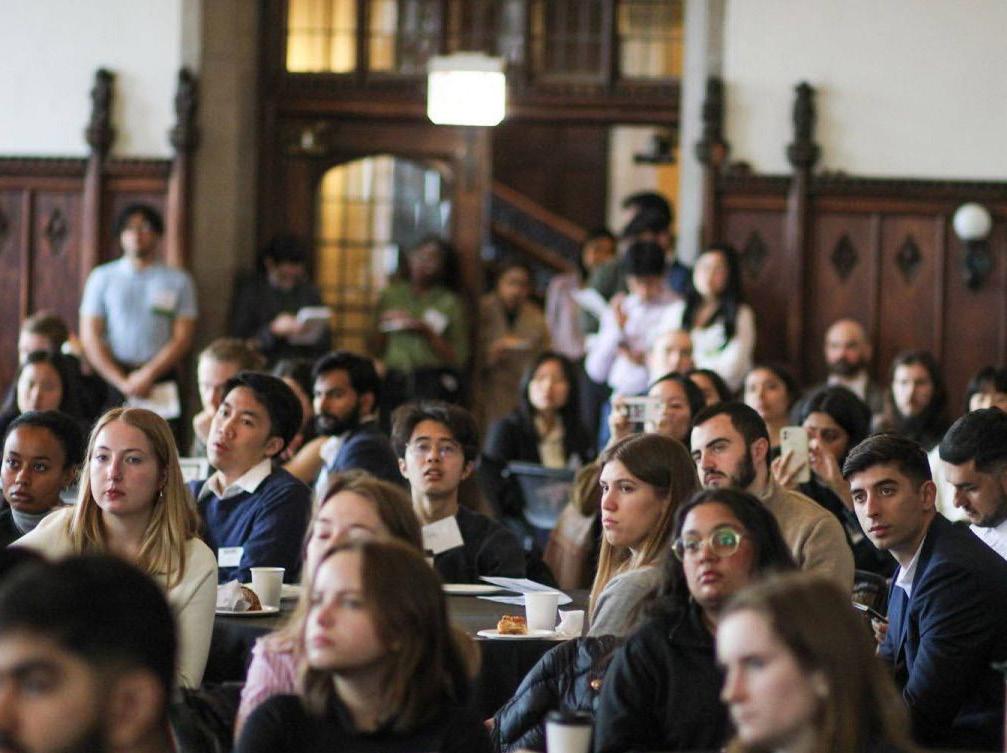
Ringness opened the day with remarks on the Biden administration’s strategy to grow the energy economy, including its investment incentives, workforce development, and research and development support.
“Overall, investments in U.S. battery and medium manufacturing have quadrupled, and nearly $150 billion has been invested in EV and battery supply chains,” Ringness said. However, she warned that uncertainties, such as a freeze on Department of Energy grants and loans, pose significant risks to the energy economy. She emphasized the importance of community engagement and advocacy in sustaining progress.
Darling addressed the growing complexities of the energy transition, highlighting a central dilemma: how to meet skyrocketing energy demand—driven by
“This institutional partnership... allows us to learn from each other... and broadens our understanding of the energy space.”
CONTINUED FROM PG. 9
AI and electrification—while still reducing emissions and ensuring a resilient energy grid. Despite the rapidly decreasing cost of renewables, he said that fossil fuels continue to dominate the global energy supply.
“Data centers in the U.S. today already use about 5 percent of our electricity. That’s projected to be 10 percent in three years,” Darling said. He framed the energy transition as an approaching systems problem. To meet this challenge, Darling referenced emerging technologies such as SMART energy plasmas, small modular reactors, and advanced catalysts for hydrogen production.
One panel focused on the clean hydrogen market in both domestic and interna-
tional contexts. “Hydrogen is going to sit with any other fuel and help the economy grow. Our energy needs are not going down—they’re going up,” said Fabrice Bonvoisin, one of the panelists. “There’s going to be room for other fuels and other types of energy to coexist, with batteries, with renewables, with natural gas, nuclear. We’re going to need all of it working together in unison to see this economy grow.” The session emphasized hydrogen’s potential in decarbonizing transportation and shipping while acknowledging cost and infrastructure challenges. Panelists also highlighted the need for international collaboration and the use of AI to improve hydrogen transactions.
Emphasizing the global dimension of
the energy transition, organizers incorporated international perspectives into the programming. “A lot of conversations about energy and climate in the U.S. are focused on domestic issues, which are important, but I really wanted to bring in global perspectives. That’s why we included a panel on energy transition in the Global South, with perspectives from Latin America, India, and Africa,” Pardasani explained.
The Global South panel examined major energy transition projects, including a 2022 initiative in El Salvador that Hong Zhang Durandal, a panelist, cited as reducing emissions by 400,000 metric tons of CO2 and saving $400 million. Panelists advocated for policy consistency, community involvement, and economic incentives
to drive sustainable transitions, particularly in developing markets such as India.
Looking ahead, the conference directors plan to continue the event annually, alternating between Northwestern University and the University of Chicago as the host campus. They aim to cement the partnership between the two institutions and continue providing students with exposure to energy-related careers.
“This institutional partnership is really unique. It’s not just about bringing UChicago and Northwestern students together— it’s about creating a space where we can all learn by doing,” Cook said. “It allows us to learn from each other, professionally and personally, and broadens our understanding of the energy space,” Pardasani added.
By JULIAN MORENO | Senior News Reporter
UChicago’s University Research Administration received notice last week that all active and upcoming grants from the National Endowment for the Humanities (NEH) to the University would be terminated. According to the NEH website, the NEH had been funding 10 active projects at the University worth a total of $3.1 million. It is unclear how much of this funding has already been allocated and what will be lost due to the cuts.
The announcement comes after the Department of Governmental Efficiency Service (DOGE) placed 145 NEH staff members—80 percent of the NEH’s staff—on administrative leave. The New York Times reported last week that the NEH planned to cancel more than 85 percent of current grants and would focus on “patriotic programming” going forward.
Founded in 1965 under President Lyndon B. Johnson, the NEH has provided over $6 billion in funding to museums, universities, libraries, and other cultural
institutions from all 50 states. Before the cuts, the NEH was funding more than 1,200 active projects and had a combined annual budget of roughly $200 million.
The NEH cancellations come amid several other cutbacks to academic research under the Trump administration. On February 7, the administration sought to limit “indirect” costs in National Institutes of Health (NIH) grants, threatening $52 million annually awarded to UChicago. NIH also canceled six UChicago research grants worth nearly $6 million in March.
Two UChicago researchers told the Maroon that NEH Acting Chairman Michael McDonald initially conveyed the grant termination to the University Research Administration, which then notified researchers. A professor in the College, who spoke to the Maroon on the condition of anonymity, described the termination letter as “laconic” and “a very weird and bone-chilling text.”
Associate professor Niall Atkinson, who leads a project to produce a digi-
tal map of 15th-century Florence, told the Maroon that the termination of his $349,969 grant was unexpected. “I called the person who was listed as our grant specialist.… She said that my grant looked good and everything was fine [on] Wednesday, and [the grant] was terminated Thursday.”
Atkinson said that his team’s planned trips to Florence to carry out topographic work and architectural analysis have been suspended. He noted that the biggest consequence of the grant termination is the loss of income for researchers on the project.
“The worst part of losing the grant is the fact that [for] my colleague who’s working out of Virginia—this was her only income,” he said.
Concerning the possibility of the University resisting the broad assault on higher education, Atkinson remarked that the University “probably can’t do much without the approval of the Board of Trustees.”
“That seems to be, for me, the real problem in getting any real action or resistance going on from the University,”
he said. “[The Trustees’] obligations are raising money and the financial soundness of the University. They have nothing to do with academics or research.”
“I think part of the reason the University is not just automatically offsetting the losses that it’s seeing in the humanities right now is that they’re… worried about more [losses] to come,” the other professor said.
The Division of the Arts & Humanities directed the Maroon to a spokesperson for the University, who did not respond to a request for comment.

.


Protests over UCMed’s lack of a Level I adult trauma center beginning in 2010 resulted in student arrests and misconduct by an undercover UCPD officer, forcing the University to reevaluate its protest policies and how it communicates them to students.
By EVGENIA ANASTASAKOS | Managing Editor, CELESTE
| Grey City Editor, and NATHANIEL RODWELL-SIMON | Deputy News Editor
This piece is the second in a three-part series on the history of protest and the disciplinary system at UChicago. It covers the period from 2010–20. Other articles cover 1967–74 and 2023 to the present day.
From 1974 to 2013, the All-University Disciplinary System—created to deal with many of the challenges that arose during the 1969 protests—was rarely used. Instead, disruptive conduct was largely handled within decentralized divisional disciplinary systems.
This was not for lack of protest on campus, however. Students widely protested the University’s refusal to divest from companies doing business with apartheid South Africa in the 1980s. Similar calls for divestment focused on the Sudanese government during a period of mass killings in the early 2000s. However, protesters in the post-Vietnam War era intentionally de-escalated their demonstrations to be less disruptive, rendering the All-University system less useful.
“After a lot of talking back and forth… it was decided that we did not want to commit civil disobedience because we did not want to divide the community,” one former protest organizer told the Maroon in 2015, referencing the 1980s anti-apartheid movement on campus.
The lull in disruptive activity on campus ended with the death of a youth activist in 2010, when demonstrators began
protesting the absence of an adult trauma unit at the University’s Center for Care and Discovery.
“There will be more actions; there will be more protests; there will be more direct actions. We’re not turned around by what happened [January 27],” a local South Side activist said in a February 2013 address to protesters outside of then University President Robert Zimmer’s house.
The University of Chicago Police Department (UCPD) and Chicago Police Department (CPD) arrested dozens of students and community activists over the following years as trauma center protests escalated.
UCPD’s conduct while handling the protests generated concerns of police overreach and called into question the management of disruptive conduct of protesters unaffiliated with the University.
As a result, the University began a new process in 2014 to reevaluate its protest and disruptive conduct policies. This process, which concluded in 2017, would ultimately result in the abolition of the All-University Disciplinary System in favor of a new Disciplinary System for Disruptive Conduct, which both removed any limitations on which University community members could file complaints and offered less transparency in its disciplinary processes.
An activist’s death sparks
For nearly three decades, beginning in the early 1990s, the South Side had no Level I adult trauma centers—hospitals capable of providing specialized, 24-hour care to adults with traumatic injuries, such as those caused by serious car accidents or gunshots.
UChicago Medicine’s (UCMed) adult trauma center closed in 1988, and Bronzeville’s Michael Reese Hospital closed its center in 1991. To receive trauma care, Southsiders needed to travel to Northwestern Memorial Hospital, 10 miles away.
The death of 18-year-old youth activist Damian Turner in 2010 gave rise to calls for a new Level I trauma center at UCMed. Turner was shot four blocks away from the hospital but had to be transported to Northwestern Memorial for care and died en route. At the time, his mother told the Maroon that she believed that he may have survived if he had been able to receive more immediate care at UCMed.
An earlier WBEZ analysis found that Southsiders had to travel 50 percent longer on average to receive trauma care. Later, a Northwestern University study would find that “Chicago-area gunshot victims who are shot more than five miles from a trauma center have a higher mortality rate.”
During a 2010 press conference organized by Turner’s mother, protesters read a letter delivered to UCMed spokesperson John Easton.
“At the same time as your hospital is embarking on a multi-million research pavilion to treat complex diseases and
surgeries, there seem to be no plans to develop the resources to treat the hundreds of South Siders dying from gun violence,” the letter read.
UCMed broke ground on what would eventually become the Center for Care and Discovery in 2009. The new facility would “transform how we care for all patients, using leading-edge technology and innovative research to deliver advanced clinical treatments in a setting that offers a superior healing environment,” according to a 2012 press release.
At an estimated cost of $700 million, the Center would include units for cancer, gastrointestinal disease, neuroscience, high-technology radiology, and advanced surgery, using its expanded footprint and larger patient rooms—along with its proximity to University research divisions—to accommodate future developments in medical technology.
Notably, the Center did not include a Level I adult trauma center.
Following the 2010 conference, organizers with Southside Together Organizing for Power (STOP) and its youth affiliate, Fearless Leading by the Youth (FLY); University student group Students for Health Equity (SHE); and several other groups combined to form the Trauma Care Coalition (TCC).
In its early days, TCC used door-todoor canvassing and student outreach to build support for its campaign demanding UCMed establish a Level I adult trauma center on its campus. They also staged protests, which included “die-ins” and a mock-funeral during a 2011 Martin Luther King Jr. Day event. By 2013, the CONTINUED ON PG. 13
“The
movement had taken a different tack—focusing on direct action against UCMed.
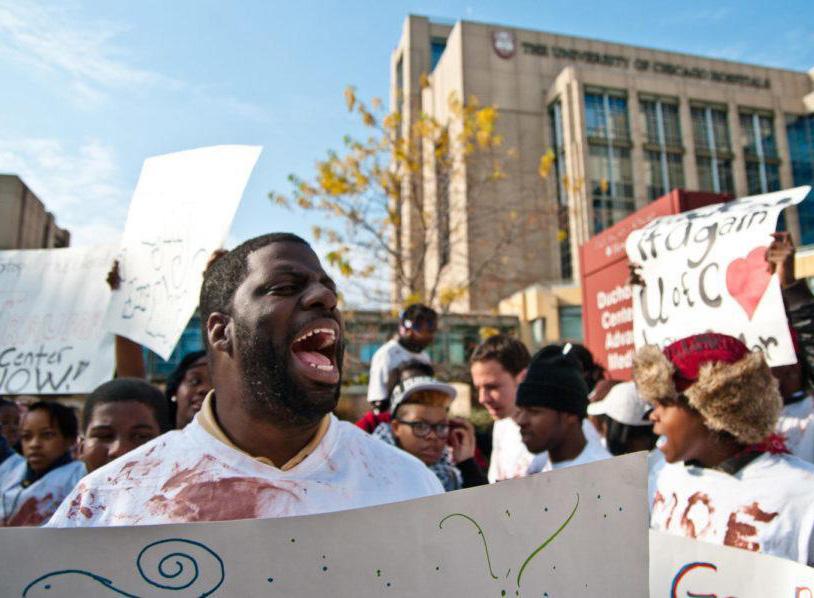
On January 27, 2013, several dozen demonstrators organized a sit-in during an invitation-only tour at the Center for Care and Discovery.
About 50 protesters entered the Center, announcing their intent to protest via a megaphone.

UCPD officers took out their batons and started shoving protesters toward the door, according to a Chicago Tribune report. Minutes later, CPD officers arrived. Several protesters said they were shoved to the ground after struggling with UCPD officers.
CPD officer Francis Frye explained that UCPD didn’t “have the expertise in dealing with crowds.”
“[UCPD] is finally getting a taste of
values and we will not tolerate it.”
what it means to be police,” Frye told the Maroon at the time.
According to a University statement, four protesters were arrested after demonstrators disregarded a UCPD request that they leave.
The Maroon identified the arrestees as Toussaint Losier, an eighth-year graduate student in UChicago’s history department; Victoria Crider, a 17-yearold student at King College Prep High School; Alex Goldenberg, the cameraman for STOP; and Jacob Klippenstein, a representative from the Anti-Eviction Campaign.
By the following week, an online petition calling on the University to explain police conduct at the protest had garnered more than 2,000 signatures. The petition claimed that police caused the only violence at the event, according to reporting from neighborhood news outlet DNAinfo. Specifically, members of STOP alleged that UCPD officers singled out Losier and beat him despite his lack of resistance.
All four arrested individuals present at the January protest were held without charges in a CPD station overnight. The lawyer for the defendants told the Maroon at the time that CPD waited on UCPD to process the charges, resulting in delayed access to counsel for the defendants.
The three arrested adults—Losier, Klippenstein, and Goldenberg—went to trial in March 2013. All were charged with trespassing, and Losier was also charged with resisting arrest.
The trial took place at the District 2 CPD courthouse. Eight University representatives were present at the trial, including five UCPD officers whom Goldenberg and Losier claimed were at the protest.
At the start of the proceedings, the University offered each defendant a plea deal, which Losier refused.
order] with the University of Chicago…. Our lawyer went back and pushed them on it. They said I was a student and that doesn’t make any sense,” Losier told the Maroon
The no-contact order would bar defendants from returning to the University and the site of many previous demonstrations. According to the defendants’ lawyer, Joey Mogul, the order would infringe on the defendants’ First Amendment right to continue protesting the lack of an adult Level I trauma center on the South Side.
On the second day of the trial, the three protesters accepted revised versions of the plea deals. Both Goldenberg and Klippenstein agreed to fewer than six months of supervision and signed a no–unlawful contact order with the University—allowing them to visit UCMed for medical care but no longer participate in disruptive protests on campus. The charges did not remain on their records. A judge sentenced Losier to a supervision period that lasted only a day.
“We took these deals mainly because we wanted to make sure that we had all the time and the resources available to us to really organize people,” Losier said in a video shared with the Maroon following the court decision.
TCC led another protest on February 23, the day that the Center opened and patients were transferred into the building. Prior to the demonstration, which included a march around the facility ending at Zimmer’s home, organizers met with UCPD and University officials to ensure that the planned activities would not interfere with medical transportation while still allowing organizers to communicate their message.
CONTINUED FROM PG. 12 CONTINUED ON
“I was offered a one-year conditional discharge, which means it goes on my record. I was also offered [a no-contact
During the demonstrations, then UCPD detective Janelle Marcellis went undercover in the crowd, actively participating in the protest while relaying information to a UCPD deputy chief. UCPD officers were stationed in plainclothes along the route and had been instructed to “blend in and get intel.”
A 2013 Maroon investigation ob -
tained photographs of Marcellis’s cell phone, which revealed texts to Deputy Chief of Investigative Services Milton Owens reading, “In crowd w[ith] sign. All is well…. They are talking about wanting three things charges dropped trauma center and police to work [sic]” She carried a sign throughout the event and put a sticker on her mouth reading, “Trauma center now,” matching many other demonstrators.
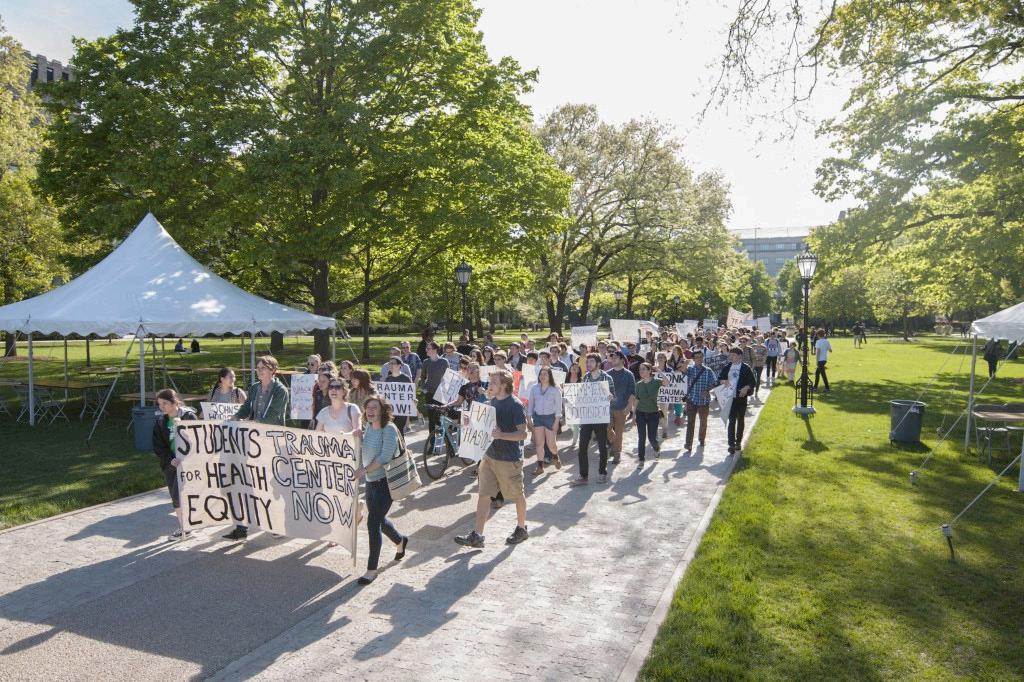
Trauma center protesters march through the quad on the way to University President Robert Zimmer’s house in 2014. chicago maroon photographic archive
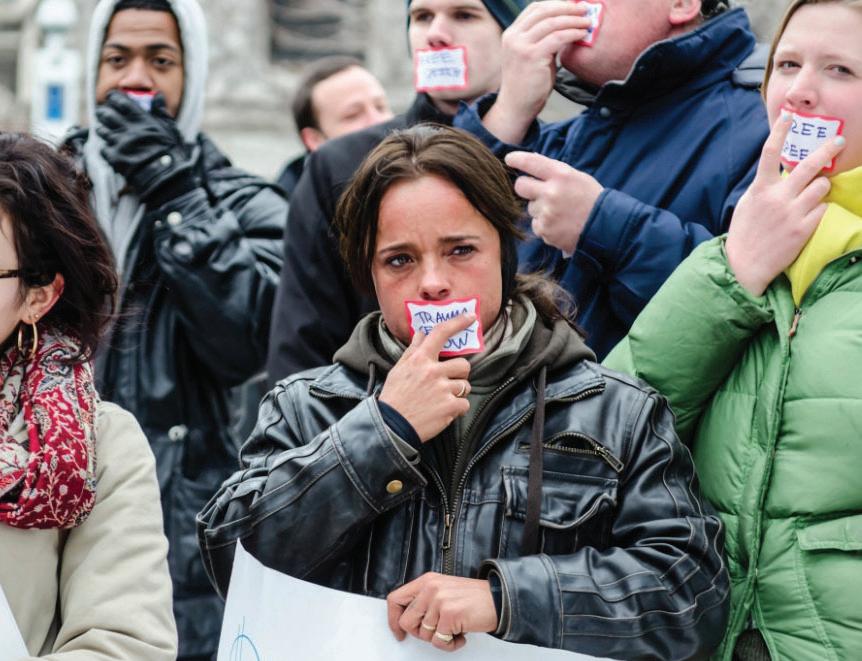
UCPD officer Janelle Marcellis holds a protest sign and wears protest tape over her mouth at a trauma center protest in 2013. She infiltrated the protest to gather intelligence. chicago maroon photographic archive.
When the investigation was published, then University Provost Thomas Rosenbaum released a statement condemning UCPD’s infiltration of the protest and indicating that it would be investigated.
“The behavior as described [in the Maroon] is antithetical to the University’s values and we will not tolerate it,”
“This prohibition, taken literally, is too broad. Vocal protest, and demonstrations in particular, are by their nature disruptive to some degree.”
CONTINUED FROM PG. 13
Rosenbaum wrote. “The University will investigate this expeditiously and take immediate steps to ensure it is not repeated.”
The University hired law firm Schiff Hardin LLP to conduct an external review of UCPD’s handling of the January 27 and February 23 protests and determine whether “University policies had been violated.” Two UCPD officers were put on leave pending that investigation, per the Chicagoist.
In line with the report’s recommendations, UCPD fired Owens, who was deemed responsible for the undercover operation, and began drafting a more comprehensive protest policy in line with “University values.” UCPD’s general orders, which govern officer conduct, now include a section specifically devoted to handling protests.
In 2018, Owens won a wrongful-termination lawsuit against the University after hearings revealed his initial skepticism of the use of plainclothes officers at the February 23 protest. Marcellis still works for UCPD as the deputy chief of patrol services.
The Schiff Hardin report also recommended a “review, assessment, and clarification of University and UCPD policies and protocols related to demonstrations and protests, including the role of the Dean on Call program… followed by appropriate training and education of all involved parties.”
Despite Owens’s initial firing and Schiff Hardin’s recommendations, activists did not believe that the University addressed all of their concerns about UCPD conduct.
“We are concerned that a few officers will be scapegoated and that the administration will not take responsibility for the implicit go-ahead they’ve given for these kinds of tactics,” SHE wrote in a statement following the announcement that an external review would take place. “The police spy was deployed in the context of [the] University[’s] disregard for
community and student concerns, and for that reason is unsurprising.”
“The report is a whitewash of what took place,” Losier told the Maroon at the time. “It reads like a defense attorney’s closing argument.”
In light of Schiff Hardin’s recommendations, Rosenbaum established the Ad Hoc Committee on Protest and Dissent (Strauss Committee), chaired by Gerald Ratner Distinguished Service Professor of Law David Strauss, to “review and make recommendations about practices and policies regarding dissent and protest on campus.”
“The environment of free expression on our campus, including the right to legitimate protest, is essential to our values and the nature of the university,” Zimmer said when the committee was announced.
Rosenbaum and the Strauss Committee held a public meeting on May 13, 2013 to reevaluate the University’s protest policies and to “review university policies on civil disobedience in the wake of questionable actions by U. of C. Police at two protests on campus,” DNAinfo wrote.

An individual speaks during a February 28, 2013 community forum addressing the University’s response to the trauma center
versity–community relationships with regard to protests. Strauss also told attendees that the committee’s role was to make general recommendations and not to dictate policies regarding UCPD.
Some students and community activists, however, felt that the committee’s role should have placed more emphasis on reforming the University’s police force.
“We’ve missed a much broader conversation about what policies the UCPD has that led to the creation of this [undercover work],” Ava Benezra (A.B. ’15) said. “And in part that’s because it’s impossible to have a conversation about the policies of the UCPD, mostly because its policies aren’t public.”
Losier also announced that he planned to file a complaint with UCPD’s Independent Review Committee based on new video evidence that contradicted UCPD’s accusation that he resisted arrest. While it is unclear whether the complaint was ever filed, Losier was later rejected in his bid for a seat on UCPD’s Independent Review Committee.
In its final report, published in January 2014, the Strauss Committee wrote that the University’s policies should clarify the disciplinary measures that would be imposed for violations of University rules.
The committee recommended two changes to University Statute 21, which defines disruptive conduct.
It called for Statute 21 to incorporate the All-University Disciplinary System’s more specific definition of disruptive conduct, which includes obstruction of “University-sponsored or -authorized activities or facilities” and real or threatened use of force against University community members as examples of relevant misconduct.
It also recommended a narrower definition of disruptive conduct to allow for vocal protest.
is too broad. Vocal protest, and demonstrations in particular, are by their nature disruptive to some degree.”
The statute was rewritten to include the more specific language in May 2014.
Despite the report’s conclusion that the All-University Disciplinary System “[had] not been used for decades and… should be re-evaluated,” no changes to its review processes or general application were made at the time.
On May 19, 2014, UCPD forcibly removed seven protesters, including three undergraduate students and two graduate students, from the construction site of a new UCMed parking garage. The protesters had barricaded an entrance to the site and bound themselves together with lockboxes made of PVC pipes, carabiners, and bungee cords. None of the protesters were arrested.
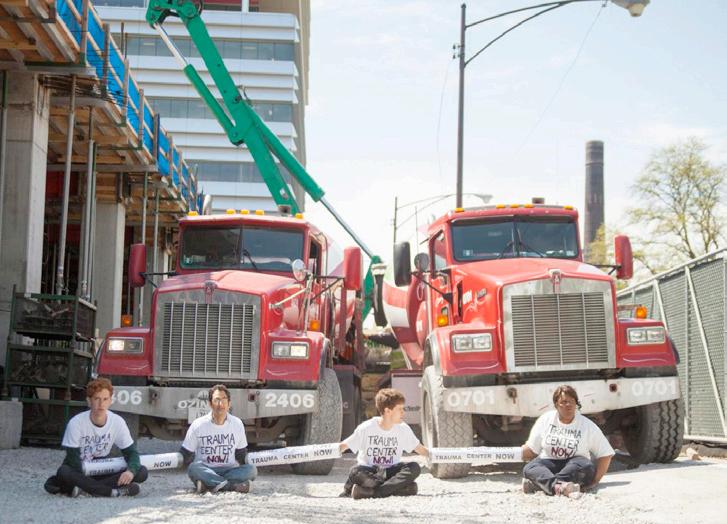
Protesters chain themselves together to prevent construction at a UCMed parking garage in May 2014. chicago maroon photographic archive
During the meeting, Strauss said the committee was focused on how, where, and when dissent and protest could be conducted on campus, as well as Uni-
“We note that the University’s statutes appear to provide that discipline can be imposed for ‘[c]onduct… disruptive of the operations of the University.’ Statute 21, Statutes of the University of Chicago (2013). This prohibition, taken literally,
The next year, the University drafted a report in response to “recent events nationwide that [had] tested institutional commitments to free and open discourse.” The report established the Chicago Principles, connecting UChicago’s history of free expression to its commitment to “free, robust, and uninhibited debate and deliberation” among University community members.
Critics of the report have since argued that the Chicago Principles were written without consultation from students and
CONTINUED ON PG. 15
“The committee’s goal was ‘to design a set of rules such that students will know how to protest and can do so safely.’”
CONTINUED FROM PG. 14
faculty, do not go far enough in protecting the right tow protest, and allow the University to avoid addressing community concerns in the name of institutional neutrality.
On June 3, 2015, protesters barricaded themselves inside Levi Hall’s south entrance vestibule and disabled the elevators until Zimmer—an ex officio member of UCMed’s board—agreed to meet with them to discuss constructing a Level I trauma center. Two hours later, members of the Chicago Fire Department broke through Levi’s drywall with axes, cut through a bike lock holding the doors closed with a power saw, and pried open windows with crowbars.
“They could have waited us out easily—instead, they called the fire department,” a protester who participated in the sit-in told the Maroon in 2025.
All protesters inside the building were arrested by CPD and UCPD. Many were banned from campus under the No Trespass (Ban) policy, which is applied to those that the University determines “has been or is threatening to be present on University property and who has engaged, or is reasonably likely to engage, in criminal activity, a violation of University policy, or conduct that is or may reasonably be deemed to be threatening, disruptive, or violent.”
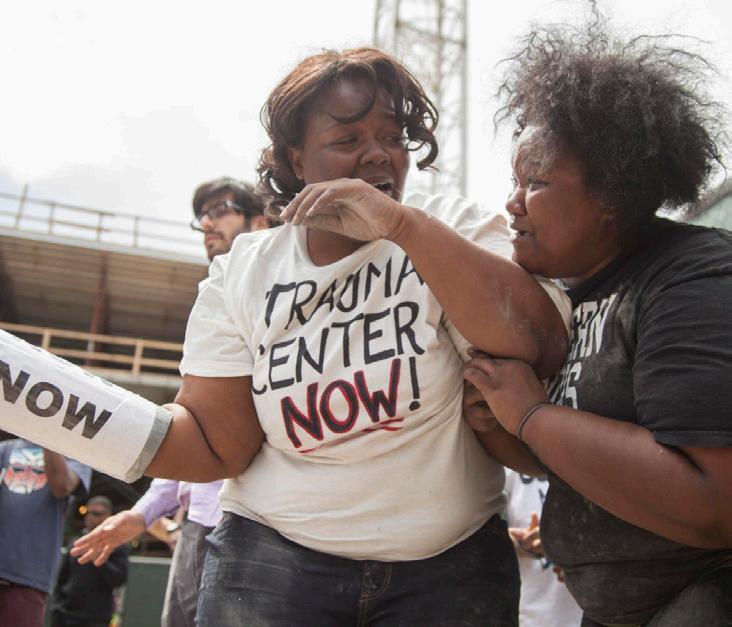
center to UCMed’s campus, a project it would finally complete in 2018.
The next major event in the University’s disciplinary history came in 2016, when then Undergraduate Student Government President Tyler Kissinger (A.B. ’16) used his expanded building access to allow protesters into Levi Hall for a sit-in to “democratize” the University and raise the campus minimum wage, among other demands.
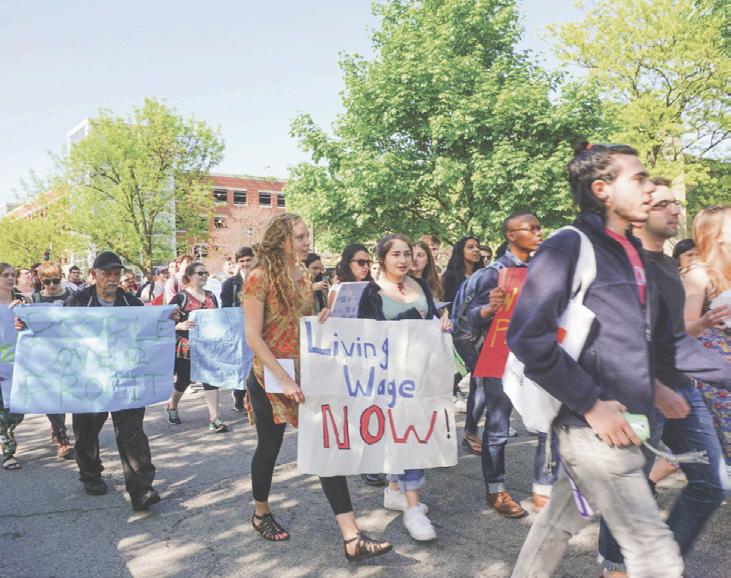
Kissinger told the New York Times tthat the University charged him with “premeditated and dishonest behavior to gain entry to Levi Hall, creating an unsafe situation” for which he was placed on probation but ultimately allowed to graduate.
No other students are listed in a 2015–16 disciplinary report as facing discipline related to the protest.
Following the sit-in, then Provost Eric Isaacs convened a Committee on University Discipline for Disruptive Conduct to “revise or replace the disciplinary procedures and standards set forth in the All-University Disciplinary System” as the 2014 Strauss Report had recommended.
The committee’s final report—the Picker Report—recommended the replacement of the All-University Disciplinary System with the Disciplinary System for Disruptive Conduct (DSDC) now in use and detailed several potential changes to the way the University handles protests, event disruptions, and related disciplinary cases.
not give rise to a potential punishment regime.”
Many of these changes were detailed in Appendix V of the report, which laid out specific plans for the construction of a new disciplinary system.
The committee’s recommendations stood in stark contrast to those implemented under the All-University Disciplinary system in three important ways.
While the 1970s procedures allowed for public hearings, under the new system disciplinary proceedings were intended to be private and confidential in line with the Family Educational Rights and Privacy Act (FERPA) of 1974.
“Although respondents, student witnesses and support persons are not bound by the federal law applicable to the University and its agents, they are encouraged to use good judgment when sharing information with third-parties, as some disclosures and related statements may give rise to legal claims against them by persons who believe that the disclosures or statements are false, invade privacy rights or cause reputational damage,” the report read.
In December 2015, the University initiated plans to add a Level I adult trauma
Kissinger and 33 other protesters briefly occupied the fifth floor of Levi Hall, where the provost’s office was located, before they were informed by an associate dean that they could face disciplinary action or arrest. All protesters then exited the building, which Kissinger described as being “kicked out.”
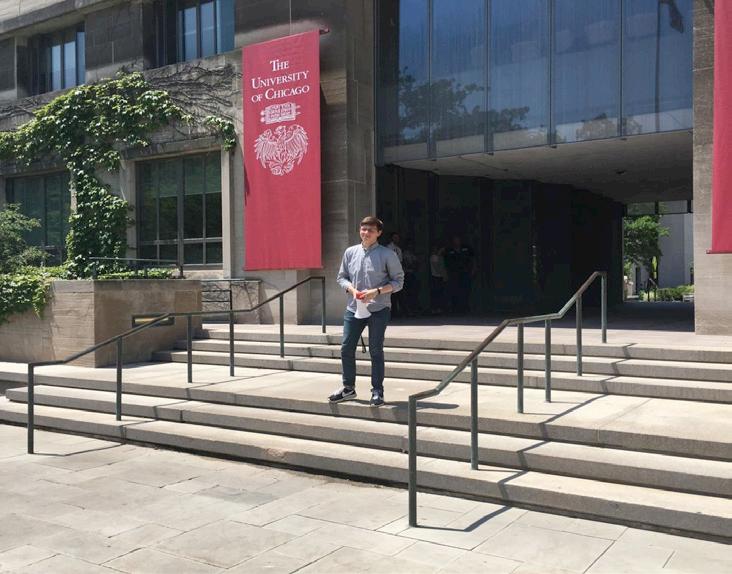
“We put together a list of what we thought of were situations that might be within the ambit of this that occurred on campus in the past couple years. The truth is the people who were appointed—it is faculty members—we didn’t necessarily know anything about this,” Committee Chair Randal Picker told the Maroon in 2017. “I gotta say—we looked at the Maroon a lot,” Picker continued.
According to the committee’s charge, the existing All-University Disciplinary system’s “cumbersome procedures,” first implemented in 1970, made it “important that an improved system be developed and approved” to address disruptive conduct. Up to this point, most disciplinary cases had been handled by individual area disciplinary committees housed within each division, which the committee argued led to inconsistent results.
Picker told the Maroon in 2025 that the committee’s goal was “to design a set of rules such that students will know how to protest and can do so safely and
The 1970s procedure had also ignored students’ previous disciplinary records. The new Appendix V established a procedure that would notify the disciplinary committee of any prior Statute 21 violation allegations against a student facing the system.
Additionally, any member of the community could now initiate a complaint under the DSDC, leaving more of this responsibility to deans.
“In SJP–Israeli conflicts, I could see either side doing that,” Picker told the Maroon at the time.
The report also suggested the addition of free speech and disruptive conduct response training to the Deans-onCall program, according to the Maroon
“We wanted to make sure that we’ve got people, deans-on-call, with special free speech training to make sure that we vindicate the rights of speakers in free speech situations to make it possible for protesters to operate,” Picker said.
“Problems that arise in connection
CONTINUED ON PG. 16
“Dissent and protest should be affirmatively welcomed, not merely tolerated.”
CONTINUED FROM PG. 15
with protest activity [can] be handled with a minimum of police involvement,” the Picker Report argued. If UCPD did need to be called in for a protest, the Report recommended that the decision be made by “high-ranking University officials.”
Losier, who as a graduate student had access to the services Deans-on-Call provide, was never able to speak to a Deanon-Call prior to or during his arrest in 2013, according to the Maroon
Picker told the Maroon in 2025 that the committee did not consider the role of the University in legal proceedings in the event of intervention from outside forces such as CPD.
The committee originally proposed further revisions to Statute 21, suggesting that several moderately disruptive incidents caused by an individual could meet the bar of “substantial” disruption, and that groups of multiple individuals could together engage in disruptive conduct.
In response to the report’s plan for a new disciplinary system, a coalition of organizations—including UChicago’s chapter of the American Association of University Professors, Faculty Forward, Graduate Students United, and UChicago Students for Justice in Palestine—released a statement of concern calling on the Council of the Faculty Senate to vote against implementation of the Disciplinary System for Disruptive Conduct.
“The Picker Report sets out to punish forms of speech, rather than fostering expression, in particular expressions of dissent that previous reports have declared essential to the University’s mission,” the statement read. “This in contrast with the [Strauss Committee report], which is exemplary in emphasizing that ‘[d]issent and protest should be affirmatively welcomed, not merely tolerated, by the University.’”
Following the pushback, a revised version of the Picker Report instead proposed the formation of a new committee in the following academic year charged with reconsidering Statute 21—the University’s definition of disruptive conduct.
A proposed revision of Statute 21 from a draft of the report was obtained by the Maroon. The bolded sections are pro -
posed additions. The final report reverted back to the version of Statute 21 still in use today.
Disruptive conduct is conduct by an individual or by a group of individuals member of the University community that substantially obstructs, impairs, or interferes with: (i) teaching, study, research, or administration of the University, including UCMC’s clinical mission; (ii) the authorized and other permissible use of University facilities, including meetings of University students, faculty, staff, administrators and/or guests; or (iii) the rights and privileges of other members of the University community. Substantiality may be judged based on a single incident or on an aggregation across incidents. Anyone member of the University who engages in disruptive conduct, whether individually or as part of a group, will be subject to disciplinary action. Disruptive conduct includes but is not limited to: (1) obstruction, impairment, or interference with University-sponsored or -authorized activities or facilities in a manner that is likely to or does deprive others of the benefit or enjoyment of the activity or facility and (2) use or threatened use of force against any member of the University community or his or her family that substantially and directly bears upon the member’s functions within the University.
“The rest of it, which is about free speech on calls and design that’s in the Report, the [faculty] council did not vote on that. That wasn’t something that the statutes required,” Picker said in 2025.
The report also suggested that “when appropriate, unaffiliated individuals who engage in disruptive conduct can be barred from all or part of the University permanently or for discrete periods under standards and processes set forth in the University’s No-Trespass (Ban) Policy.”
“The committee met with many people,” Picker said in 2025, recalling one area on which it received pushback. “I think there are some people who would have liked for there not to be the possibility of expulsion for engaging in disruptive conduct,” he said.
The new DSDC included a provision requiring a review in spring 2020. A review was conducted, according to Anthony Casey, the chair of the 2025 review
committee, but he said there were few incidents the new system had been used to address by the time of the review and there was consequently little to assess.
Casey said he did not have documentation of the 2020 review—which he was not involved in—and the Maroon was not able to locate any formal record of it.
Many UChicago student organizations supported the wave of national protests sparked by the 2020 murder of George Floyd by Minneapolis police officer Derek Chauvin, demanding that the University abolish its private police force.
In June, protesters affiliated with several campus activist groups, including #CareNotCops, UChicago United, and Students Working Against Prisons, staged an overnight sit-in at UCPD’s headquarters. Protesters demanded a public, in-person meeting with then University Provost Ka Yee Lee and former UCPD Chief of Police Kenton Rainey; a 50 percent reduction in UCPD’s budget for the 2020–21 school year; and the eventual abolition of the force.
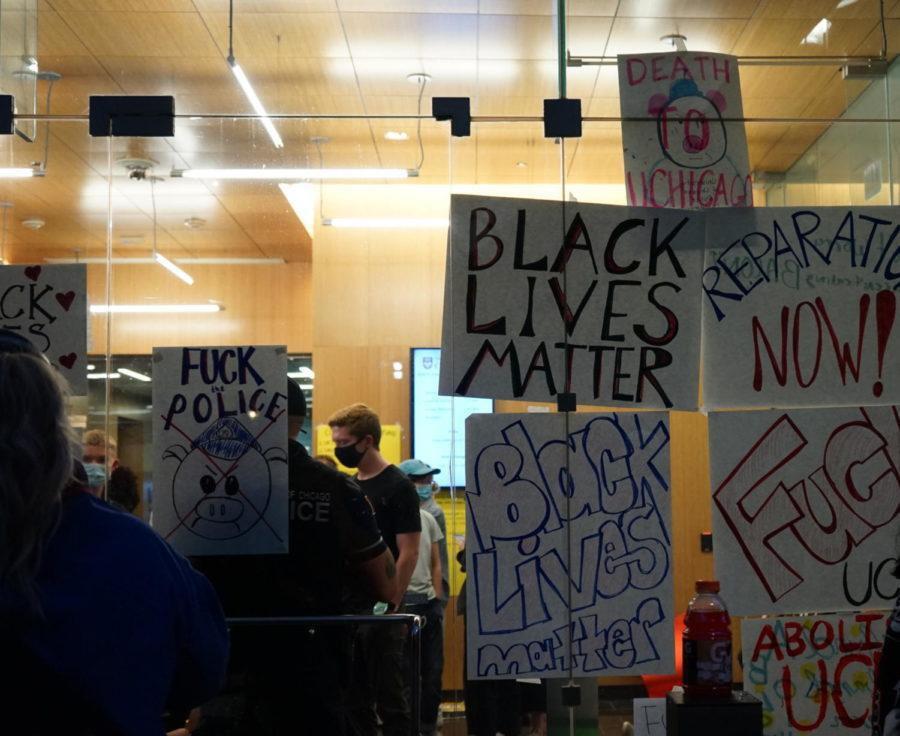
Protesters with #CareNotCops stage a sitin in the lobby of the UCPD headquarters. chicago maroon photographic archive
Protesters were allowed to leave the building during the entirety of the protest, which lasted until about 10:30 a.m. the following morning. The building’s bathrooms, however, were locked, and protesters were unable to get food into the building after 5 p.m. Although Rainey and Lee agreed to a meeting, it is unclear whether it ever took place.
With their demands from June still unmet, protesters with the #CareNotCops campaign occupied the block out-
side of Lee’s home beginning in late August to again demand that she disband UCPD and create cultural centers and an ethnic studies department on campus.

Chicago Police look on at a protest by #CareNotCops in front of Provost Ka-Yee Lee’s house, September 2020. chicago maroon photographic archive.
Over the course of several days, protesters erected tents and barriers on the sidewalk despite multiple police orders to disperse. Protesters also spray-painted messages on the sidewalk outside of Lee’s house in English and Chinese that some on social media condemned as anti-Asian racism.
In a statement published during the protests, Lee expressed her willingness to meet with protesters but condemned many of their tactics.
“Unfortunately, the actions that are currently taking place on my doorstep go beyond any civil bounds,” she wrote. “In addition to engaging in unlawful residential picketing for three days, protestors have harassed and directed personal attacks and vulgar language at my family members and me, verbally and in writing, and blocked traffic for community members on my block. They have spray painted offensive messages in both English and Chinese on my street and outside my home.”
Despite the University’s efforts to completely overhaul its disciplinary system and better handle disruptive conduct, no students were disciplined for their actions at either protest.
This piece was produced by the M aroon ’s Investigations team, whose members are Celeste Alcalay, Evgenia Anastasakos, Elena Eisenstadt, Gabriel Kraemer, Zachary Leiter, Tiffany Li, and Nathaniel Rodwell-Simon.
Jerry Coyne, a professor emeritus in the Department of Ecology and Evolution and the “duck-master” of Botany Pond, spoke to the Maroon about the pond’s new inhabitants.
By NATALIE EARL | Staff Photographer
It is time to get excited for spring! Our beautiful campus is beginning to bloom, and the days will (hopefully) be warmer from here on out. Most importantly, ducks have officially returned to the Botany Pond, and UChicago’s resident expert, professor emeritus in the Department of Ecology and Evolution Jerry Coyne, assured the Maroon that they are here to stay.

Coyne can tell Esther apart from Dorothy and Honey, female ducks from past years who have not returned, by the distinctive black markings on her bill.
According to Coyne, Esther has been “window-shopping” for a place to build her nest in the second-floor alcoves of Erman Biology Center that face the pond. Coyne expects Esther will build her nest within the next week, then begin laying eggs— only one a day—until she is satisfied with her clutch. Once Esther settles down to incubate the eggs, it will take about 28 days for them to hatch.
To those who are wondering how the ducklings get down from the second-story window ledge, the answer is simple: they jump! Most of them can jump straight into the water, and those that do hit the ground land on a cushion of grass. Having monitored this process many times, Coyne claims that the ducklings seem to recover just fine and waddle themselves the rest of the way over to the pond.
Coyne has requested adjustments that will allow the ducks to get in and out of those areas.
Coyne is also working to get the livestream—which was turned off when the restoration process began in 2022—turned back on, giving the University communi-
ty a 24-hour look at Botany Pond. When it was in operation, the livestream received viewers from all over the world, Coyne said.
The turtles, of which there used to be over two dozen, will be reintroduced over the summer along with fish.
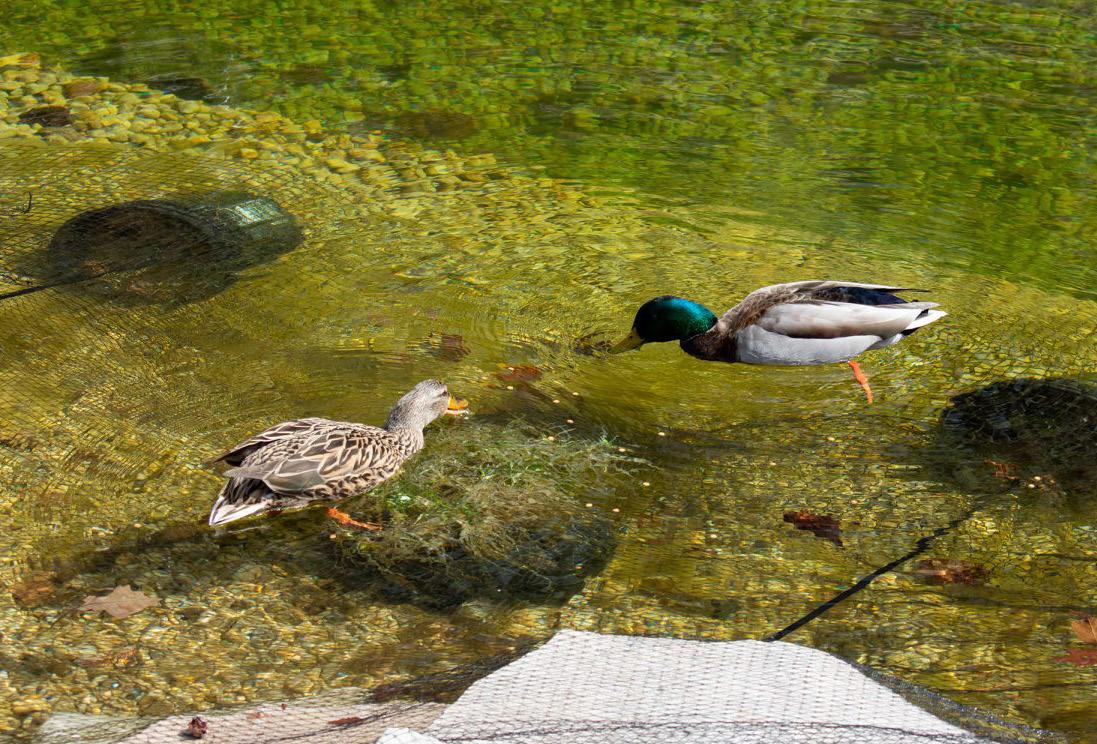
Jerry, as he introduced himself, has been the pond’s “duck master” for the past eight years. He keeps watch over the mallard ducks from his third-floor office in the Zoology Building and comes down to feed them nutrient-packed pellets twice a day. Contrary to some rumors, the University does not bring the ducks to Botany Pond. The mallards find and choose Botany Pond as the place to hatch the next generation of ducklings all by themselves.
Coyne witnessed the arrival of the newest breeding pair of mallards on March 14, and they have been at Botany Pond every day since.
Since the Jewish holiday of Purim, which celebrates the saving of the Jewish people from annihilation as recounted in the Book of Esther, also fell over March 14 this year, Coyne named the new ducks Esther and Mordecai after the heroes of the story.
There was one time though that Coyne had to intervene. In 2020 Dorothy and Honey were competing for space at Botany Pond.
Dorothy claimed space in the west windows of Erman Biology Center, above the patch of grass between the pond and the building, while Honey built her nest in the east windows of the building, 30 feet above stone pavement.
At Coyne’s urging, former University President Robert Zimmer directed a facilities team to put a duckling trampoline beneath the nest. That year’s duckling-hatching day was so harrowing that the Chicago Tribune wrote that it was “as action-packed as an Avengers movie,” with “death-defying leaps from tall buildings! Violent feuding! A fired gun!”
Coyne told the Maroon he’s glad to have just one pair to watch out for this year.
As reported in December, the restoration of Botany Pond is complete. The black fencing, in place to protect the new plants, will stay up for the time being, but

When professors elect to use AI, they replace teaching with efficient but harmful shortcuts.
By CAMILLE CYPHER
The conversation surrounding the academic use of AI typically centers on the potential harm to students’ learning. When English majors are using AI to write everything from a full essay to a 100-word discussion post, and computer science majors are relying on DeepSeek for coding assignments, how could it not do educational damage? Certainly, the gratuitous use of AI in schooling will negatively affect students. This detriment doesn’t just stem from students using AI as a substitute for learning, but also from professors who use AI as a substitute for teaching.
Within days of ChatGPT’s introduction, students adopted AI into their academic routines: editing essays, solving statistics homework, and generating ideas. While AI may increase accessibility, quality of education, and personalization of resources, it also leads to cheating, plagiarism, and overdependence on technology. And though AI has become deeply ingrained in our academic lives, it is relatively new, and its impact is relatively unknown. We know that AI is a shortcut, but we don’t know if it will ultimately function to expedite our learning processes or prevent them.
Now, in what feels like the second wave of AI usage—in which every company has added “AI-powered” to its slogan— professors have caught on to the shortcut as well. Many UChicago professors allow AI as an editing tool for essays. Some allow any AI usage with citations. And
some have even swapped teaching assistants and p-sets for AI substitutes. Though these tasks can help students learn to navigate AI in an increasingly technological society, problems arise when professors completely replace teaching with AI.
Last quarter, my professor for Public Policy Analysis implemented AI resources such as All Day TA and Personify in our coursework. Both resources use course materials to answer questions and supply practice problems, marketing themselves as tailored teaching assistants. Though the resources are occasionally helpful in answering simple, course-related issues, they are, overall, an inhibitor to learning. All Day TA generally supplies identical practice problems to those from the textbook, homework, or class notes, and it answers little more than basic questions about the course material. The resource is redundant for any student with the syllabus or textbook open, saving only a few seconds of navigation. Even further, students are required to complete all of their homework on Personify, which is the more problematic substitute for teaching. The resource is frequently incorrect, and on multiple occasions, I and other students had to submit the same answer at least three times before Personify solved the equation for itself. Additionally, Personify gives students the answer with little to no pushback. If a student struggles (or pretends to struggle) for the answer for three queries or more, Personify will solve the problem for them, asking the student to
check the math and submit the spoon-fed answer. While some might use these resources for their intended purpose—as an explanatory tools to help stuck users navigate past roadblocks— most students, managing a full course load and other stressors, fall to the temptation of an unearned answer.
So, students take to Personify because it hands them an easy A. In fact, the average on every Personify-based homework assignment was over 94 percent— in stark contrast to the D-minus average on the midterm and C average on the final. In a class that touts a no-computer policy and cites the benefits of handwritten notes, AI is not accelerating but completely bypassing the teaching and learning processes.
Outside of this class, the examples are endless. A friend’s creative writing professor required students to edit and submit an AI-generated essay. In another friend’s graduate-level class, professors allowed students to use AI if they could edit pieces enough to disguise their usage. And, most existentially, an email recently went out from the Human—Robot Interaction Lab to the Department of Computer Science detailing a potential research project meant to create “a robot that can teach pairs of children social emotional learning skills” and another “autonomous robot system that can be deployed in a child’s home.” This last example alone seems to entirely threaten the sanctity of our most formative human relationships, reshaping all forms of learning, from the
home to the classroom.
Homework is one of the most fundamental components of students’ learning, particularly for STEM classes, which require students to complete practice problems to succeed in later stages of the course. And yet, as resources like Personify and All Day TA mislead both professors and students into believing they have a better grasp on the material than they do, AI becomes a shortcut to an A, bypassing the slow yet necessary learning process. Consequently, when the time comes for AI-unassisted learning, students can’t replicate the processes they’ve merely skimmed for homework, banking on grading curves rather than genuine, long-term understanding.
Shortcuts help us get places faster. We take the hypotenuse when we can, use Excel spreadsheet hacks to expedite the mundane, and take the off-ramp when we see traffic. If there is a faster way to accomplish something, we take it. But learning and teaching are processes that
depend on trial and error, collaboration, and time. AI shortcuts are meant to be efficient, but learning is, at its core, inefficient. Sure, spending less time generating problems, understanding concepts, or finding resources can speed up learning and even out the academic-financial playing field, but, in these examples, the learning process is sidestepped, not expedited. When AI circumvents the learning pathway, it undermines students’ ability to understand the material, especially when teachers elect to use it, too. AI is still in its early stages, so, naturally, we are also in the early stages of its applications. It will take time for professors to find the right tools that accelerate rather than replace teaching and learning. Until then, both students and professors will have to resist the temptation to take shortcuts that may get us where we’d like faster, but on a much less stable foundation.
Camille Cypher is a third-year in the College.
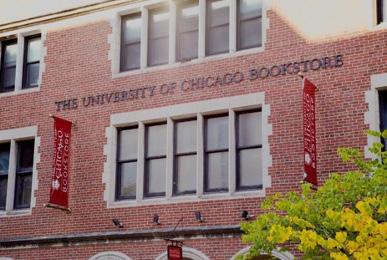
We ought to properly discuss our campus’ cesspool of fraternity culture.
By SHAWN QUEK
The University “where fun goes to die” seemingly defies its reputation.
A Friday night. A familiar scene unfolds. A vast house, its exterior decaying, yet alive with a buzz of youthful energy. The thumping bass of a mid2010s pop playlist seeps out into the yard.
In the basement, a game of beer pong plays out, a competition so fierce it might be game seven of the finals. Above, a bomb site resembling a kitchen, the countertop a graveyard of empty cans and cartons, while in the corner a lone soul concocts a drink so strong it could strip paint.
Crowds pulse in and out of dimly lit rooms, laughter ringing over the crinkle of red Solo cups. Odors of cheap beer mingle with juvenile desperation and misplaced promise. The air is a cocktail of inebriation and exhilaration. The night is messy, loud, and utterly unforgettable.
Here, social hierarchies bubble like a pan sauce, reducing in alcohol and patriarchal bravado.
Amid the laughter, spilled drinks, and sprawled bodies, you realize, for all its absurdity, this chaotic, uniquely American ideal of fun is alive and well at the University of Chicago.
Fraternities, mysteriously absent from official University messaging, are a staple of the social scene on campus. These exclusive all-male societies have historically had a troubled relationship with the press, appearing in headlines alleging
misconduct, depicting them as housing racists, sexists, and rapists.
As a straight-passing man, I have had candid insights into these male-dominated spaces; some members suppose I’m “one of them,” and others are willing to break vows of secrecy to share their experiences.
In the fall, the campus blooms with bizarre fashion choices. In lecture halls, seminars, and on the quad, freshfaced first-years don suits and ties, Playboy Bunny lingerie ensembles, chicken costumes, and, my personal favorite, paddles of Perry the Platypus onesies.

sitting down. At the scattered laughter, he muttered, “Pledging.”
Pledging is a secretive fraternal initiation process, also defined as “a binding promise.” Some carry that commitment in memory. A man I spoke to, and many others, carry it in scar tissue.
“It was completely consensual,” S.B.—a former member of a fraternity on campus, whom I interviewed anonymously—recounted, laughing. He described the ritual to me as a joke between brothers.
A metal coat hanger, twisted into a Greek letter, heated in a cast-iron pan slick with olive oil. The press of searing metal against skin. The sharp sizzle, the stench of burnt flesh.
M.D., a first-year fraternity brother with whom I also spoke anonymously, described the branding as “Fucking nasty. When my buddy showed me, it was literally his entire fucking ass cheek with the logo on it, and it doesn’t go away. That is incredibly dehumanizing.”
impacts their bids in joining the fraternity. M.D. explained: “Pledge tasks are pretty ubiquitous things at any school. The ones here are not egregious for the most part.”
M.D. went on to give an example of a pledge task on campus: “A nicotine pledge. You just carry nicotine at all times. Frat X has eight of them, I think. You carry Zyn [pouches], vapes, cigarettes, whatever the brothers request. You make deliveries. If someone calls you like, ‘Yo, can I get a cigarette?’ you got to run across campus and go see them. You might miss class. It sucks.”
Why do fraternities require such arduous, embarrassing hazing? “[You’re] being forced to wear ridiculous stuff around campus, you’re getting yelled at together,” S.B. said with warm nostalgia. “You’re doing all this dumb stuff together. I think you do grow closer in that time.”
memories perhaps more fondly than I should. My experiences speak to an insidious narrative within masculinity: it teaches that one should be grateful for their suffering.
Fraternity hazing is different. Where military rites at least claim to be in service of an external good—defense, survival, discipline—fraternity hazing is recursive. The trials and tribulations of pledging seem to be self-sustaining and artificially manufactured.
As S.B. said, “Trauma bonding, that’s all it is, right? It’s just light hazing.” S.B. admitted that apparently the “light hazing” of coat hanger branding, verbal abuse, and public embarrassment exist for the sake of bonding brothers.
According to fraternal edicts, new members look after items at all times. My statistics classmate once kicked open the door to a lecture hall 15 minutes late wheeling in a mop and bucket. Another classmate in my Classics seminar thumped a cinder block onto his desk, unbuttoning his blazer before
S.B. chuckled. “I don’t really think about it unless I’m telling this story, because it’s, in my opinion, funny.” A coat hanger branding, a permanent scar— somehow, a punchline. The absurdity would almost be amusing, if it weren’t so revealing. Although he was branded with a coat hanger, his lighthearted recollection of the “bonding” he felt during the pledging process felt simultaneously familiar and perplexing.
Other than branding, some fraternities also have assigned tasks attached to pledgeship. Pledges’ completion of tasks
Though I have personally never pledged to be in a fraternity, the trials and tribulations one undergoes to become part of a patriarchal in-group—a space perpetuating traditional gender roles by prioritizing male authority—are not beyond me.
One might say that I have been hazed before. That is not what it was called, of course. My rugby team called it bonding. My military called it training. My firefighting academy called it conditioning. The logic is the same: the forging of loyalty through suffering, the consolidation of power through pain.
Much like the fraternity men I interviewed, my quests for worthiness were far from pleasant, but I recall these
M.D. imparted a similar sentiment: “Yes, it’s a quarter of ‘I’m this guy’s bitch.’ Whatever, I have to do some gross shit. Oh, I have to drink, but it’s nothing. It’s not fucking World War III, like, there are schools where it is quite literally hell on earth.”
S.B. frankly reflected on the issue, “That’s just the nature of pledging, right? There’s a power dynamic, it’s reinforced.” The Stanford Prison Experiment–esque power dynamics present in the pledging of new fraternity brothers highlight another cultural aspect that dominates one’s attention: the unavoidable stench of testosterone and masculinity.
Hazing in fraternities, much like any other ritual of initiation in a patriarchal group, creates and reinforces the fraternity’s internal logic, as S.B. said: “With any kind of hazing
CONTINUED FROM PG. 19
ritual, there is a sense [of] ‘I went through this. I’m on the other side. Now, I’m gonna have some fun.’”
Psychologists write about fraternity hazing as a deeply embedded part of the social fabric of college, one that furthers itself through a cycle of conformity, and submission. It is a ritual that demands submission to a perpetuation of domineering masculinity.
My two sources were quick to remind me that, in the grand scheme of fraternity hazing, UChicago is nothing compared to schools with more intense fraternity culture. M.D. claimed, “Frat hazing in Chicago, maybe you think it’s not great, but keep in mind, this is the most watered-down hazing possibly in the entire country.”
“Watered-down” or not, the logic remains the same. The bond of suffering is foundational for the next cycle of
hazees. Members are initiated through the same violence that “proved” predecessors as worthy of brotherhood, manhood, and belonging.
Despite the tribulations, young men remain drawn to fraternities for the brotherhood, lifelong friendships, and community. The majority of fraternity brothers, much like the rest of the student body, are in their first years of adulthood at an academically brutal university.
Men may be particularly vulnerable to loneliness and the mental illness that follows. The harmful effects of traditional masculinity lead to loneliness and isolation. Myths of masculinity prevent men from being emotionally available to others and themselves, and one must dismantle these notions to free men from loneliness.
I know firsthand the outdated expectations of masculinity, having internalized from
society, that, simply put, “boys don’t cry.” These masculine expectations set forth by societal norms of being stoic and emotionless are insidious obstacles to the vulnerability required in the male quest for belonging and community.
I find myself in the trenches alongside the men fighting a silent, increasingly uphill battle against loneliness and mental illness. One finds an irreplaceable community through brotherhood. Can anyone fault men looking for a sense of belonging?
Though the importance of community is not lost on me—I, myself, have found solace in the friendships derived from other forms of brotherhood—the question remains: What makes fraternities stand out from other groups? Why not look for a community somewhere less controversial?
The answer lies in these societies’ unique ability to pro -

vide access to alcohol. As S.B. frankly stated, “It was a place to drink on the weekends and friends to hang out with.”
M.D. furthered this sentiment, admitting, “If you’re under 21, it’s hard to be super social, extroverted, and go out as a guy if you’re not [in] a fraternity, unless you have the world’s greatest fake ID and a group of friends that always want to go out.”
America remains a country where the majority of university students are not above the legal drinking age. For these undergraduates—full-time students and part-time underage drinkers—the fraternity house is their only option for an alcoholic third space. That is, at least, until they move off campus or find other means.
In the holy halls of the fraternity house, alcohol is the great emancipator. Within these underaged drinking cathedrals, cheap beer flows as holy water, acting as both the congregation’s lubricant and its sanctifying agent.
M.D., having previously worked as a sober monitor at his fraternity house, recalled the scenes vividly: “I literally have had to walk around in a yellow vest at parties, like, ‘Oh, my God, this girl’s passed out.’
I can’t tell you how many times that happened.”
The comical proportions of American fraternity drinking are indicative of a collegiate liberation from an alcoholically oppressive society imposing a ludicrous legal drinking age, a relic of a bygone era. Fraternities don’t just normalize binge drinking—they industrialize it.
A 2018 study found that by age 35, nearly half of former frat members show signs of alcoholism.
S.B. admitted he barely remembers the night he was branded: “Oh yeah, I was shitfaced.” A moment of permanent scarring, blurred by intoxication—like many things in frat culture, a ritual sustained by alcohol and amnesia.
The process of fraternal drinking, much like hazing itself, is not merely about pleasure or camaraderie. This coupling is a performance, caricaturing drunken masculinity, enacted not just for the self, but—in more ways than one—supplied for an audience that insists upon it.
The fraternal combination of alcohol and patriarchal culture, an American collegiate staple, creates risks that go beyond what one encounters elsewhere. Caitlin Flanagan emphasizes this criticism in her essay for The Atlantic, “The Dark Power of Fraternities,” claiming fraternities outpace commercial spaces in harm, especially as a result of the absence of responsible oversight.
As M.D. conceded, “You’re less likely to get raped [or] roofied at a bar than you are at a fraternity. Maybe that’s a reflection on how fraternities throw parties. At a fraternity, the likelihood of being raped is exponentially higher because that’s where everyone goes out.”
Flanagan criticises the current fraternity model, arguing that frat brothers are tasked with enforcing national rules they have no interest in upholding. She argues that the national guidelines for permitted practices, sober checkpoints, and guest lists read as a bureaucratic satire—impossibly detailed yet laughably ineffective. Though fraternities refuse
CONTINUED ON PG. 21
to follow national chapter rules, they are not lawless spaces. They are instead governed by entrenched patriarchal values.
Lucia Roure, a first-year and sorority sister of Alpha Omicron Pi, described it as such: “Frat culture as a whole, there’s something to be said about [women] being viewed as an opportunity. What I mean by opportunity [is] if there are more girls, you’re probably [at] better odds of hooking up with one.”
The notion of the “ratio” in American fraternities—a numbered balance between men and women at social events—reveals broader societal dynamics surrounding gender, power, and objectification. At these events, fraternities impose the belief that having more women increases the event’s success.
As second-year Attila Newey describes: “Frat parties are designed for people to hook up, people are making out everywhere. It’s kind of foul. You’re all very close together. It’s dark, everyone’s drinking. The ratio is a symptom of that, assuming that the majority of [the fraternity’s] brothers are straight, and you’re prioritizing their interests, then you want less competition in a wider pool. This feels [like] very objectifying underlying thinking.”
Newey’s take might seem exaggerated, but it captures an uncomfortable truth: “The ratio” isn’t just party logistics. It is a fraternal economy where women’s presence is currency, traded to maximize male pleasure. It’s a system where desirability is quantified, where access is controlled, where the unspoken male logic remains: more women, less competition, better odds.
During a peer review session on Aristotle—because, of course, this is still UChicago—I mentioned to a friend of mine that I was writing about fraternities and was curious about her experiences. She told me of a system she had learned to guarantee men entry to frat parties, despite “the ratio.”
She described how, while en route to “fratting,” she and her female friends were in the habit of taking off their jackets, pulling down their shirts, and throwing their hands over the men in their friend group, as though they were together.
The combination of cleavage and commitment to companionship would make the pledge at the door more likely to let the whole group in, rather than just the women, she explained. In a moment of vulnerability and self-reflection, she said it in plain English: “I feel so icky partaking in my own objectification.”
This feeling of discomfort with one’s commodification encapsulates what is so insidious about “the ratio” in frat culture. As bell hooks argues in The Will to Change: “We need to highlight the role women play in perpetuating and sustaining patriarchal culture so that we will recognise patriarchy as a system women and men support equally, even if men receive more rewards from that system.”
“The ratio” is a fraternal calculus of patriarchal power where female presence is commodified to reinforce gendered power structures. When one is told that there needs to be a certain number of women relative to men, it does not simply mean more women are invited to participate.
In the study “Why Is Fra -
ternity Membership Associated With Sexual Assault?”, Seabrook et al. conclude: “The pressure men feel to uphold masculine norms, their endorsement of these norms, and their acceptance of objectification of women help explain why fraternity members are more accepting of sexual violence.”
This objectification entrenches traditional gender roles where men are active— controlling the party, space, and rules—and women are passive, their worth defined by their enhancement of the male experience. Even if fraternity members don’t consciously view women this way, “the ratio” surely influences their interactions with women in these spaces and beyond.
While “the ratio” may seem like a simple calculation, it operates within a broader racial and cultural matrix where women of color, non-cisgender, or non-heterosexual women are often hypersexualized, exoticized, or excluded entirely. Any critique that overlooks these intersections risks overlooking the complexity of the issue.


Gender, race, and sexuality intertwine to create unspoken social hierarchies of desirability. Sociologist Katherine Cross elaborates: “To some white men, Asian women top their hierarchies of desirability. But what do those women get out of that? Suffocating stereotypes of docility; discrimination; abuse…. These hierarchies of desirability determine your value to people in positions of relative power and privilege. Thus, even being at the top isn’t a guarantee of good treatment. It just makes you the prime cut of meat.”
“The ratio” reveals a plague of patriarchy that treats women’s bodies as sites of male enjoyment, an illness that collegiate culture is all too ready to expose to our youngest and most vulnerable. There is a particular danger, as Roure said, “especially when you’re younger, looking for validation from an older [fraternity] brother.”
“The ratio” poses a challenge for men, too. It is a Herculean task for a non-affiliated man to enter a frat party.
In 2024, Newey starred in the YouTube video “How to get into ANY Frat party,” which
has accumulated over 24,000 views. In an interview with the Maroon, Newey summarized what men face: “There’s a bunch of pledges on the door. You just have to do these ridiculous things to try and get in, or know multiple brothers.”
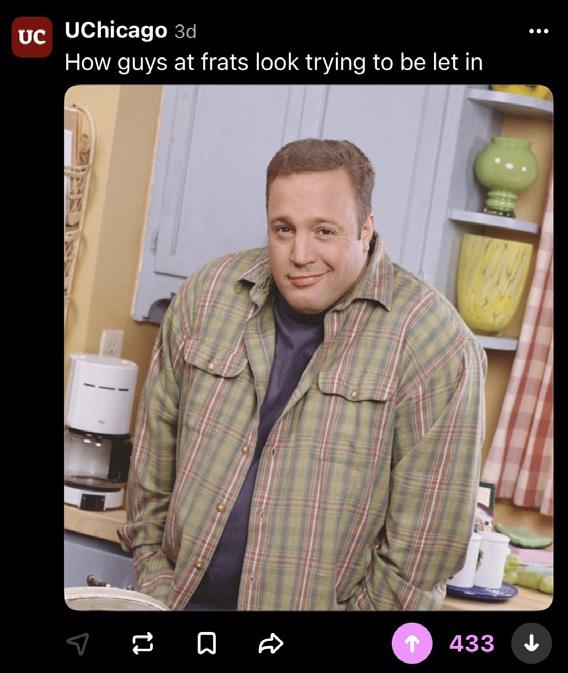
Newey’s video asks: If men can’t get into a frat party but women can, what if a man dressed up as a woman? At 6’3”, Newey’s goal of blending in with his entourage of female conspirators was no easy feat.
On camera, he shaved his armpits, is embellished with fake eyebrows and eyelashes, dons a bald cap and a blonde wig, purchases an XXL sports bra, fills it with water balloons, then applies the finishing touches of contouring makeup and an off-the-shoulder top to complete the look.
Beyond his brief labor of conformity to feminine beauty standards, video production research meant that Newey had become a bona fide expert on the fraternity subculture. According to his interviewees, denial of entry to fraternity parties had nothing to do with the heteronormative elimination of competition driven by
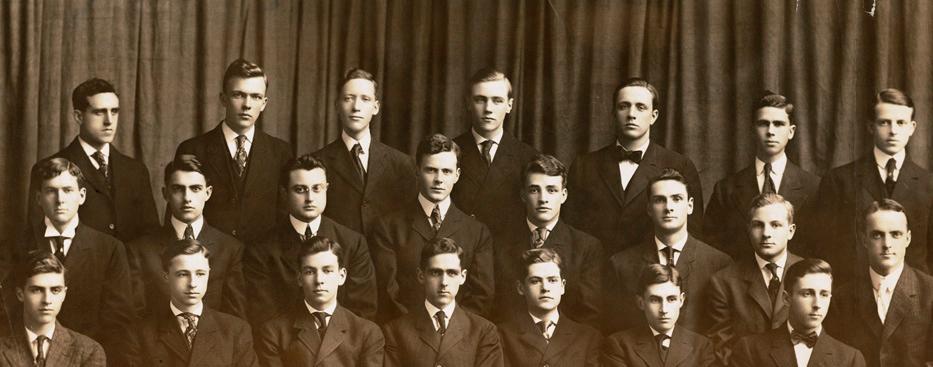
CONTINUED FROM PG. 21
misogynistic thinking.
Allegedly, the denials of entry relate to the possibility that a partygoer commits sexual assault. He said: “They don’t want to be liable for men making bad decisions at the parties, but I don’t know. Cases [such as in the video] where ‘if you fight over this pothole, you can get in.’ That doesn’t test if [a man is] going to sexually assault someone. Those two things do
not correlate!”
A more intriguing aspect of Newey’s project was the choice of fraternity to infiltrate—Delta Upsilon, which, following a string of controversies, is now known as Iron Key Society.
This piece is the first of two installments, the second of which will appear in the next print issue of the M aroon . The article is published in its full form on chicagomaroon.com.
University senates around the country are organizing and speaking up. It’s time for university leaders to end their silence.
By CLIFFORD ANDO
Where do things stand in the war being waged by our own government on research and higher education?
The assault has taken place along at least five major fronts. First, the federal government has terminated many grants for research, including at the Department of Health and Human Services and the National Institutes of Health (NIH), or has unilaterally changed the basic terms of contracts postaward. The cancellation of nearly all grants from the National Endowment of the Humanities (NEH) and the laying off of NEH staff are the latest actions of this kind.
Both the actions themselves—pauses in funding, termination of grants, and changes to contract—and the manner in which they have been performed raise procedural, statutory, and constitutional is -
sues. Litigation is ongoing, and many complainants have been successful in obtaining at least temporary redress. The judges in question have been sharp and succinct in calling out the illegality, and often the cynicism of federal actions. See, for example, John McConnell Jr.’s decision on the Office of Management and Budget (OMB)
“pause,” Loren AliKhan’s decision on the rescission of the OMB “pause,” and Angel Kelley’s decision on the violation of the Administrative Procedures Act in NIH grant terminations. Second, in gross violation of the statutorily mandated procedures of the Civil Rights Act of 1964, the government has withheld or threatened to terminate millions or even billions of dollars of grants and contracts with Columbia University, the University of Pennsylvania, Princeton University, Harvard University, and Brown University. (Many
other universities have been told that “investigations” are underway.) The best characterization of these actions might be hostage-taking, because where conditions for the restoration of funds have even been specified, the ransom notes have arrived only after the news has broken that funds are being withheld.
Third, the federal government has canceled the visas of, detained, and deported or sought to deport large numbers of foreign members of university communities. The effort began with select students and researchers, but is now culminating in a more silent and vastly larger effort to cancel student visas across multiple states. All this is above and beyond forbidding entry to the United States by foreign academics who are coming as visitors to U.S. universities.
It cannot be emphasized strongly enough that the conditions of possibility for research
in the United States, and for academic speech and free inquiry at universities in particular, have been altered beyond recognition. Projects have ended; researchers are being laid off; no foreign student or instructor can speak without fear, even in class. Those who are quiet, hoping the chalice will pass them by, are fundamentally mistaken regarding the objective conditions of their existence. Instead, they are electing merely to witness, without protest or counterargument, the dismantling of American higher education.
But there is more. The fourth front of the war on the research university is visible in the conditions specified for the restoration of funding to the universities under threat or, in Columbia’s case, in the preconditions laid down for the start of negotiations over the restoration of funding. In their details, these amount to a direct assault on the autonomy of uni-
versities and the exclusive role of academic judgment in academic matters. Columbia was told, first, to place an outsider in supervision of academic affairs in a given department. As a second matter, the university was enjoined to make professorial appointments in multiple departments, in which the viewpoints of candidates on policy issues will determine whether their application gets full consideration. Nonrational—non-epistemic—appraisal was to take priority over academic judgment. And Columbia agreed.
Finally, the federal government seeks to instrumentalize universities in the policing of speech. This is visible in the demands that Columbia change both its rules of conduct for community members engaging in political speech and its practices of policing. It is also visible in the requirement that
is to
that has values and is willing to act on them.
CONTINUED FROM PG. 22
Harvard “commit to full cooperation with DHS [Department of Homeland Security] and other federal regulators, and make organizational changes as necessary to enable full compliance.” And it is palpable in the fear created in foreign students and scholars when Marco Rubio, the Secretary of State, issued a directive ordering the scrutiny of social media accounts of student visa applicants, citing an executive order that urged, “the United States must ensure that admitted aliens and aliens otherwise already present in the United States”—students and scholars on visas—“do not bear hostile attitudes toward its citizens, culture, government, institutions, or founding principles.” Thought is now grounds for the cancellation of visas and de jure deportation. Free inquiry is impossible when people are afraid.
How should universities respond? Or, more specifically, what should universities say? I place an emphasis on speech for several reasons. First, since the methods of the government are largely illegal, universities must (among other things) be political. Its power being force, it can be opposed by speech that reveals its nakedness. Second, an important context for the current fight is the catastrophic loss in public esteem by research universities in particular, as revealed inter alia by the annual Gallup poll on higher education. A first step in winning back the public’s confidence would be to claim to have values and to be seen fighting for them—and I’m not talking about indirect cost recovery.
Finally, we should not forget that universities are also ethical communities, which is one
of the reasons they are fragile. Bonds of affection must be sustained and renewed. An outward-facing statement of values would also have an internal audience of faculty, staff, students, and alumni, people whom it is worth reassuring and who also can be mobilized.
There is now action on this front, but not from universities, their presidents, or their trustees. Instead, the most striking recent development in the current struggle is the flood of resolutions from faculty senates, together with public letters by faculty at institutions without senates. The senates at the University of California, Berkeley; New York University; Rutgers University; and the University of Virginia have already spoken. Hundreds of faculty at Harvard have written to the Harvard Corporation. Faculty at Harvard Law School wrote to their students. I have been informed that the senates at the University of Michigan and Yale University are seeking to act. (Please observe that the University of Chicago is not on this list. I’ll come to that.)
Notably, many of these documents ask that their universities act in coordination with the sector as a whole or, in the case of Michigan and Rutgers, close coordination within the Big Ten. A similar move is underway to produce a joint statement by the faculty senates of the Jesuit colleges and universities, an effort that might be expanded to include Catholic institutions of higher education more broadly.
The rush of letters from faculty and senates is also diagnostic for what it reveals about the silence of others. What does it mean that the faculty are speaking up but, in general, universi-
ty leaders are not? (The public statement about Rümeysa Öztürk by Sunil Kumar, president of Tufts University, and the legal action taken on Öztürk’s behalf by the university are notable exceptions.) A narrow claim might be made that university presidents are being tactical: they hope that silence will allow their institution to escape notice. But neither silence on the part of Columbia and Brown, nor preemptive submission on the part of Harvard—adopting a controversial definition of antisemitism, removing the faculty directors of the Center for Middle Eastern Studies, canceling a public-health partnership with Birzeit University in the West Bank—spared those universities.
A different sort of tactical claim would be that leaders of universities should not make promises they cannot keep or draw red lines they cannot enforce. But no one believes that a university can stop the federal government, nor are people so naive as to believe that a president who promises to assist students in returning to campus for their studies can somehow override the cancellation of a visa. What people want nonetheless is to belong to an institution that has values and is willing to act on them. They want leadership. The hunger for that is palpable.
It is also possible that, in some large ecology of speech acts, university leaders are relying on (powerless) faculty senates to offer public statements of principle, knowing that no one can demand that a faculty senate redeem the validity of those statements. Let senates perform this work, while old-fashioned lobbying, conducted by realists, goes on
in smoke-filled rooms. Finally, it is possible that presidents are being constrained by, or are simply of a mind with, the people who truly run modern universities: their trustees.
To my mind, what is needed, both within and without the university, is clear and direct affirmation of the essential prerequisites of education, inquiry, and research, namely: autonomy, openness to the world, and freedom of speech. That these are civic virtues in a democratic society to which all collectives can aspire should allow universities to stand forth not simply as advocates for themselves, but as beacons of virtue in a troubled time.
Where does the University of Chicago stand? It so happens that the Statutes of the University of Chicago state that the president of the University is the presiding officer of all ruling bodies, including the Council of the University Senate, the elected representative body of the tenure-track faculty. The faculty of the University of Chicago—its Senate—therefore cannot speak as a collective unless the president allows it, nor can the Senate speak without formally implicating the Uni-
versity’s leadership. Here, the faculty doesn’t speak, at least not to the public.
But they can speak to their representatives. On April 2, 2025, a group of faculty submitted a formal request to the Committee of the Council, asking it to seek from the president and provost a public statement about values they endorse and red lines they will not cross. Last week, the president called for a special meeting of the Council of the Senate on Tuesday, April 8 to discuss the federal context—though discussion of the faculty request for action has been scheduled for a smaller meeting of a select committee only the following week.
To President Alivisatos, and to university leaders everywhere: For the sake of the institutions and, indeed, the calling to which we have dedicated our professional lives, please stand up. We stand with you.
Clifford Ando is the Robert O. Anderson Distinguished Service Professor in the Departments of Classics and History and in the College, as well as Extraordinary Professor in the Department of Ancient Studies at Stellenbosch University.
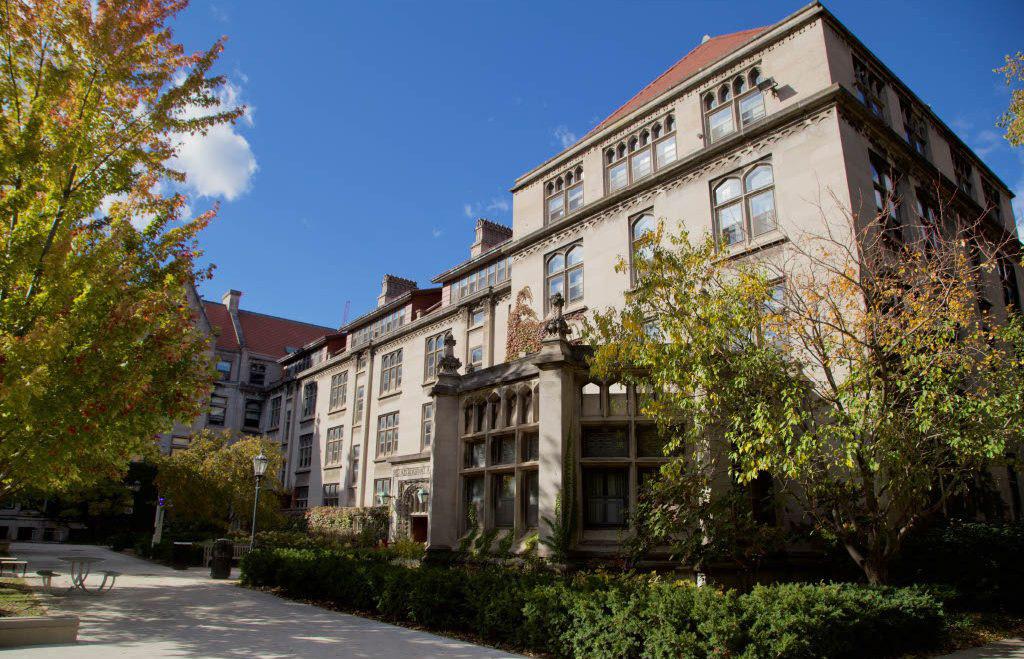
Maroon
photographer Graham Hansen
takes a walk around Hyde Park, cataloging the sculptures that call the neighborhood home.
By GRAHAM HANSEN | Staff Photographer
Construction in Space and in the Third and Fourth Dimensions
Antoine Pevsner, 1962

Construction in Space and in the Third and Fourth Dimension stands steadfast through its 61st winter outside the D’Angelo Law Library. Neither its sculptor, Antoine Pevsner, nor the architect who suggested a Pevsner work be installed outside the University of Chicago Law School, lived to see the sculpture installed. The winter snow does little to subdue its golden-bronze glimmer, leaving only a little dusting on its slopes.
Carl von Linné Monument Frithiof Kjellberg, 1891
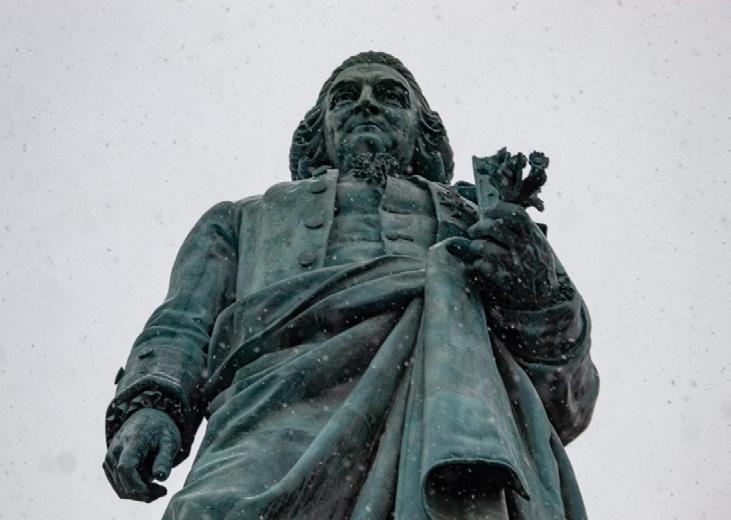
The scientist Carl von Linné, responsible in part for the modern biological classification system, peers through the snow across the Midway Plaisance, where he is stationed. Located just outside of the south entrance to Harper Memorial
Library, the statue moved into its present location in 1976 after 85 years in Lincoln Park. He serves as a diligent observer of the boulevard ahead of him and a sentry for the campus behind.
Diarchy
Kenneth Armitage, 1957
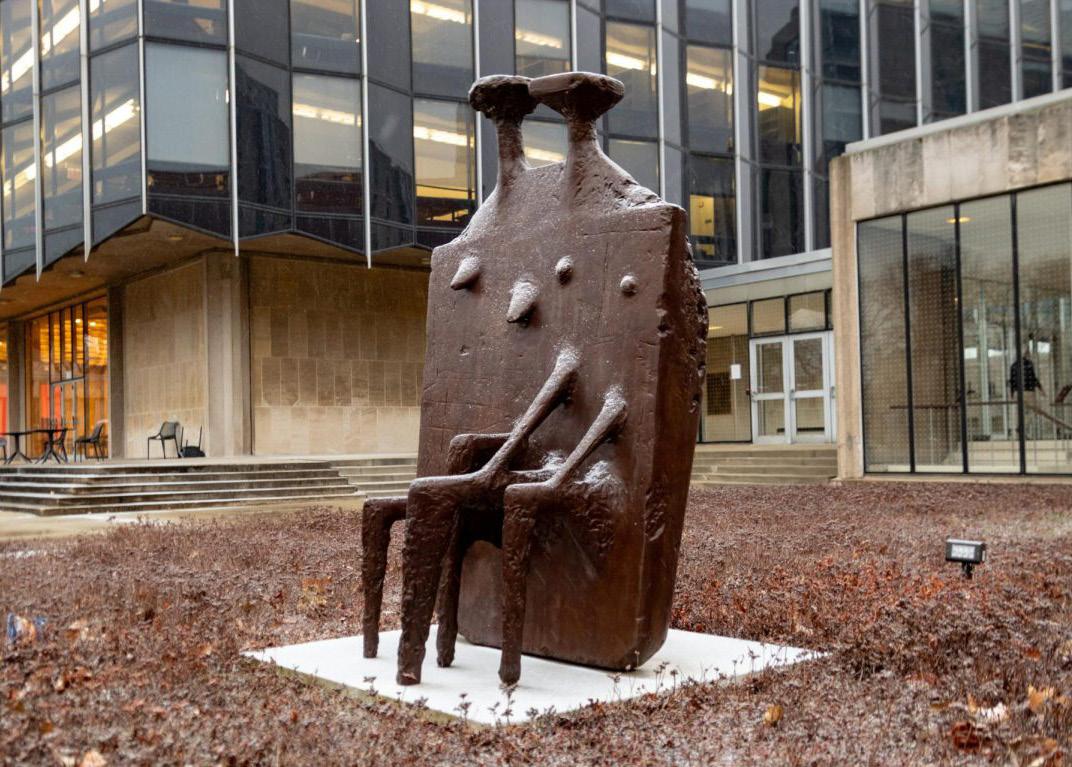
Diarchy appears with its varied appendages and surfaces in the corner of the Laird Bell Law Quadrangle. It is textured and complex, never opening up for easy interpretation. The name of the piece, thought up by a member of the British Council, reflects the two seated rulers visible in the sculpture’s form. Diarchy ’s twin currently resides in London’s Tate Britain Museum.
Walt Whitman Simon Gordon, 1958
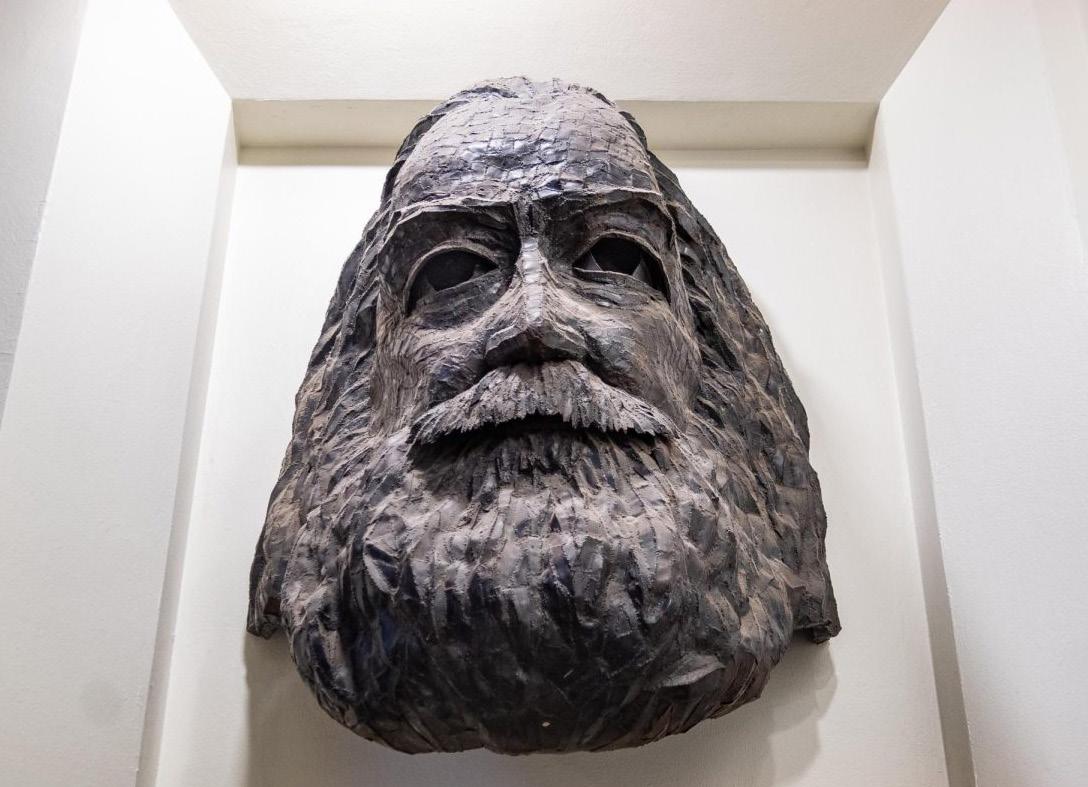
In “Song of Myself,” Walt Whitman asks, “What is that you express in your
eyes? It seems to me more than all the print I have read in my life.” His statue gazes at students traveling up to the Harper and Stuart reading rooms, where he doubtless hopes they will read some poetry. In his rough, sculpted face lies eons of wisdom. The Harper stairwell is not the only place Whitman’s statue has lived. Previously, it hung in a Wieboldt Hall computer lab.
Dialogo Virginio Ferrari, 1971

Virginio Ferrari, the sculptor of Dialogo, intended its four sections to send a message about the unity of continents. Instead, students joke that its hammerand-sickle-like shape is supposed to be a political message. The forgiving snow, instead of sliding down, chooses to cling to the sculpture’s slopes.
di Pietra (Ideas of Stone) Giuseppe Penone, 2004

to be a winter tree with rocks visiting its branches, inviting students to the Booth School of Business courtyard that surrounds it. A closer look reveals a veneer of bronze rather than wood. 21 years ago, Penone collected the sculpture’s rocks from the river outside his home.
Thalidomide #12
Jonathan Schork, 2019

In an otherwise blank segment of the Midway Plaisance, an odd hand reaches up to greet us. It is Schork’s 12th work in a series of tree carvings attempting to display the effects of the pregnancy drug thalidomide on limbs. The position of the sculpture’s fingers may also remind viewers of the peace symbol.
Garrigue Masaryk Monument
Albin Polásek, 1949

CONTINUED FROM PG. 24
snow. In real life, the statesman worked to found the country of Czechoslovakia after a period as a scholar in the United States. In bronze form, Masaryk has stood as a valorous protector of the Midway Plaisance since the 1950s.
Transformation or Green Lady Gary Keenan, 2020
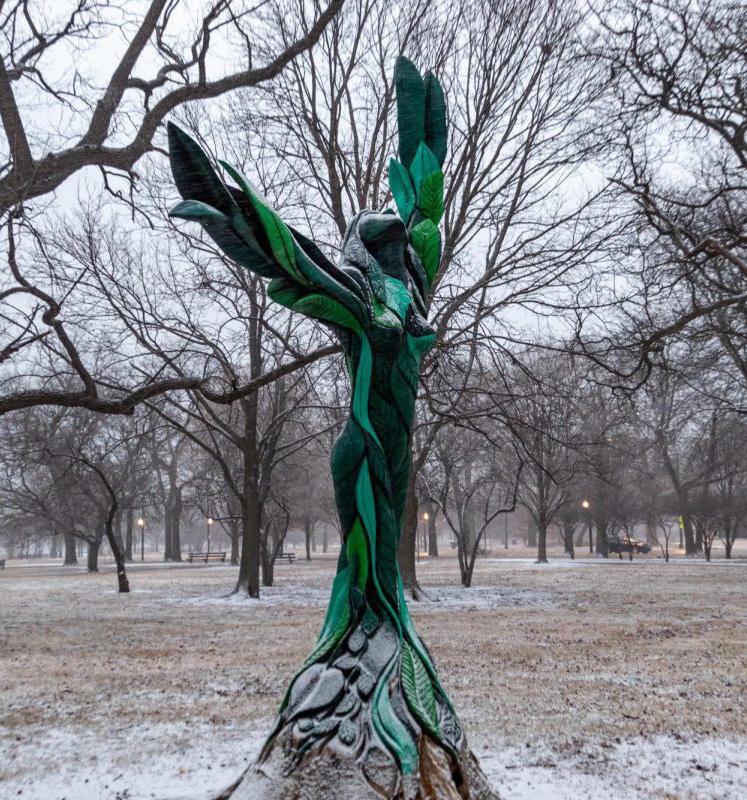
Transformation or Green Lady emerges from an ash tree near the 59th Street Metra tracks. Her green beauty conceals a difficult past: the original tree was corroded by emerald ash borers, an invasive species of beetle. Chainsaw artists like Keenan see this invasive species not just as a force for destruction but also for rebirth.
Majoris
Nancy Rubins, 2017

Perhaps the most complex sculpture in the Hyde Park area, Agrifolia Majoris intrigues the viewer immediately but takes a minute to truly appreciate. Its amalgamation of animals showcases the complexity of nature by subverting expectations of direction and dimension. A delicate network of wires holds the precarious arrangement above the grass and the water below.
Daniel Chester French, 1918
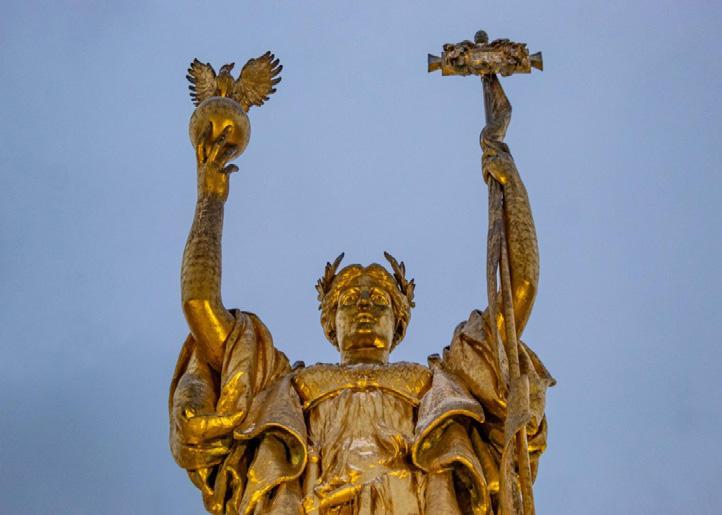
Columbia towers pleasantly over a wintry Jackson Park. She takes her form from French’s much larger statue, The Republic, displayed at the 1893 World’s Columbian Exposition. Unlike the temporary plaster of the world’s fair, this incarnation stands strong in gilded bronze as a landmark of the South Side. Her message is one of peace and prosperity for the nation.
Sky Landing
Yoko Ono, 2016
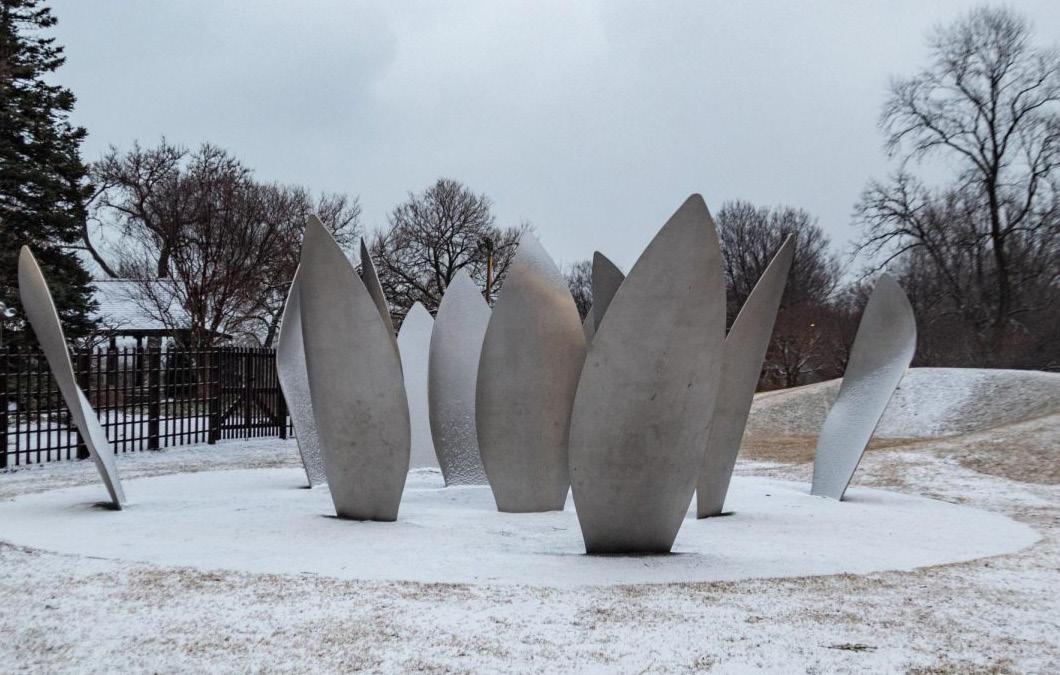
Sky Landing depicts a dozen flower petals reaching toward the sky, inviting viewers to “Imagine” what future awaits them. Fittingly, it was designed and installed by the renowned, imaginative musician and artist Yoko Ono. Beside the sculpture lies the preserved Japanese Pavilion of the 1893 World’s Columbian Exposition.
Mother and Child
Sorel Etrog, 1968
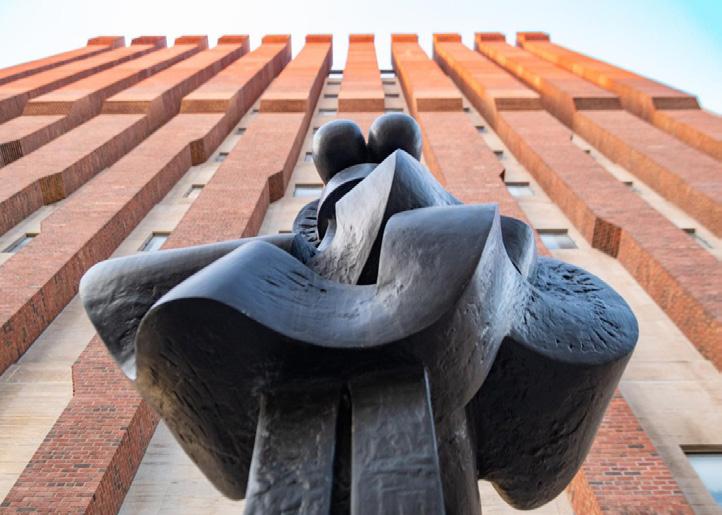
stracted form of one of humanity’s most fundamental human relationships. Its position in front of Cummings Life Science Center, flanked by medical school and science buildings, is fitting. Viewed from below, the sculpture displays maternal power.
Terrence
Karpowicz, 2024
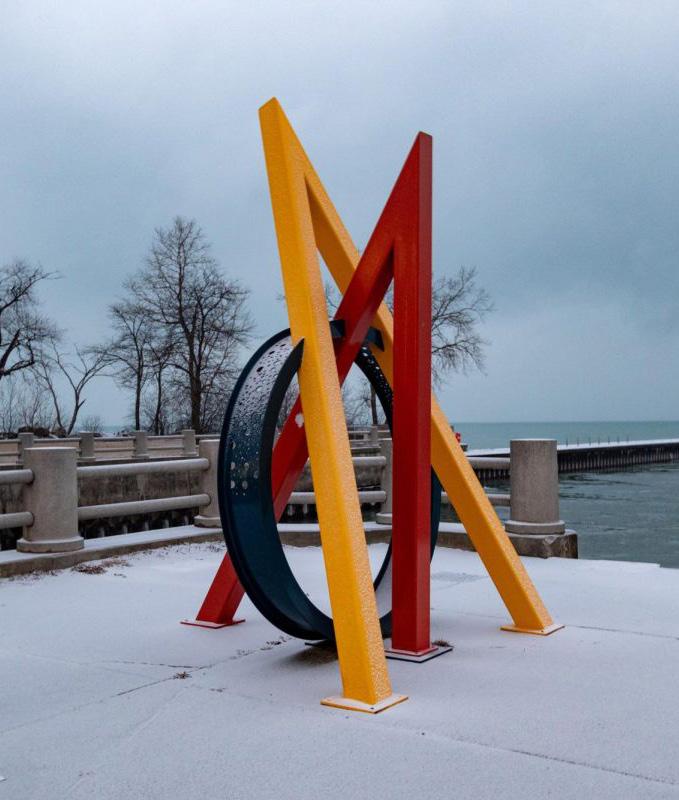
The few strong lakefront trekkers in the middle of winter will find Reaching for the Stars up against the frigid water. Its multifaceted, futuristic form demands to be viewed from all angles. When standing perpendicular to the yellow segment, viewers may notice a striking connection to the Deathly Hallows of the Harry Potter series.
Lorado Taft, 1922
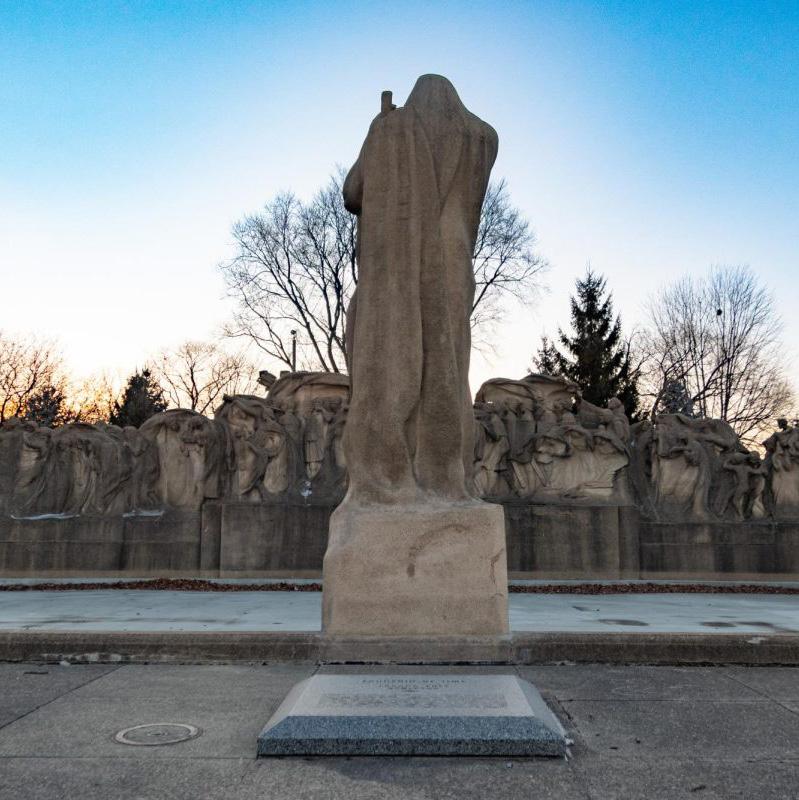
UChicago lecturer Lorado Taft considered the work his very best. Henry Austin Dobson’s poem, “The Paradox of Time,” which inspired the sculpture, notes, “Time goes, you say? Ah, no! Alas, Time stays; we go.”
Grande Disco
Arnaldo Pomodoro, 1968
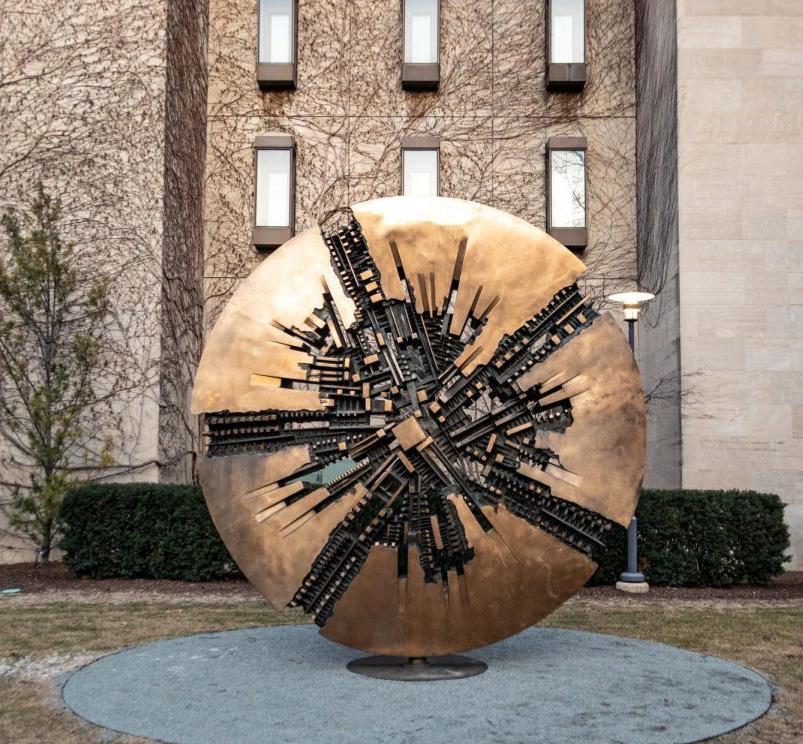
With its sleek bronze parts, Grande Disco reminds the University of its technological innovations and creativity. Students and visitors can enjoy swiveling the sculpture around its post on the Crerar Quadrangle. Its complex shape simultaneously connotes an intricate machine and a fractured disk.
Henry Moore, 1968
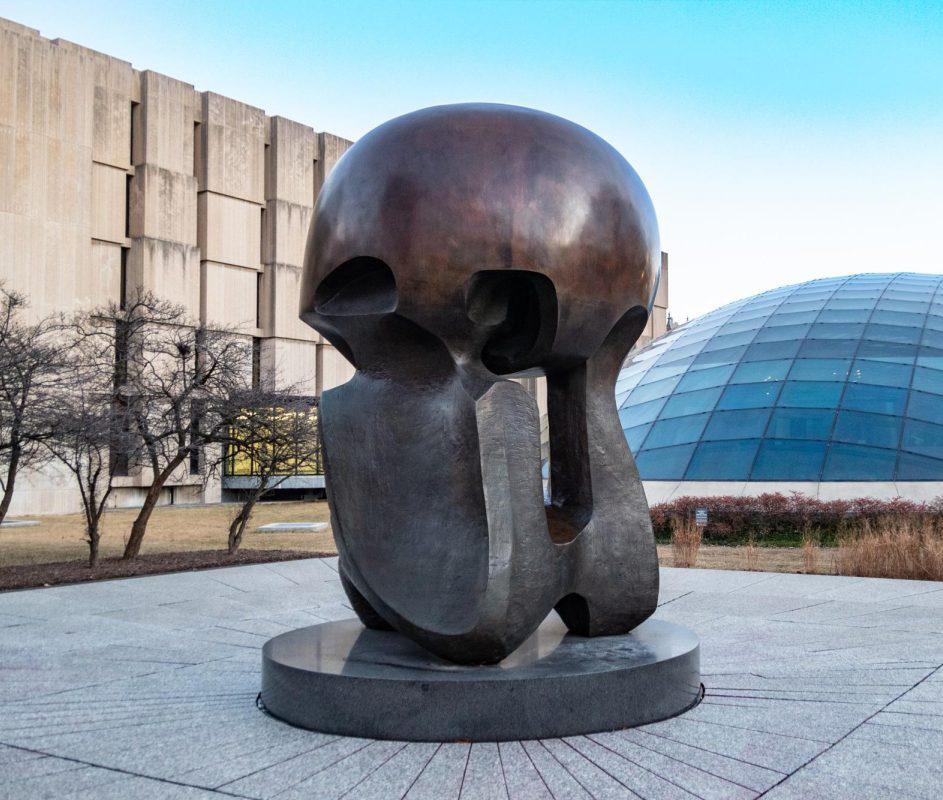
Henry Moore’s iconic Nuclear Energy sculpture commemorates the site of Chicago Pile-1 with an abstracted combination of a mushroom cloud and skull. The sculpture is located near the location of the world’s first self-sustaining nuclear chain reaction, created by Enrico Fermi under the bleachers of the old Stagg Field in 1942. Each academic quarter, students gather around the sculpture on the Monday before finals for the minute-long Primal Scream.
By MAROON ARTS
Want recommendations but don’t know where to look? If the answer is yes, you’re in luck—starting this week, you can check every print edition of the Maroon for “Maroon Musings,” where your Arts editors (and a special guest) each recommend one thing that should be on your radar over the next two weeks. This week’s guest is Tiffany Li, editor-in-chief of the Maroon
Tea Time Concert: Game Music Ensemble April 17, 4:30 p.m., Fulton Recital Hall. Free admission.
Tea and cookies, plus a blend of chamber music arrangements of music from your favorite video games.
Tiffany Li, editor-in-chief
Swara Sudha: Celebrating Rama Navami April 25, 6 p.m., Rockefeller Memorial Chapel. Free admission.
A South Indian classical concert featuring renowned artists. Sure to be a melodious and vibrant celebration.
Nolan Shaffer, head arts editor
Made in Dakar
An album by a Senegalese Afro-Cuban jazz group with excellent tunes to unwind.
Shawn Quek, associate arts editor
Lennart Anderson: A Retrospective Through May 2, John David Mooney Foundation. Free admission.
An exhibition of the late American painter, whose realist style was inspired by that of the Old Masters.
Elizabeth Eck, associate arts editor
LITERATURE
“This is it”
A new book of poetry by UChicago Ph.D. candidate Léon Pradeau.
Emily Sun, associate arts editor
Heavyweight
Listen on Spotify, Apple Podcasts, and Amazon Music.
A (recently renewed) human-interest podcast that connects guests with a person from their past.
Miki Mukawa, head arts editor
UChicago’s women’s distance medley relay team took home the University’s first national track and field championship in four years and first track championship in nearly a decade.
By JOSH GROSSMAN | Sports Editor
“Nerds, nerds, nerds.” As third-year Emma Kelly passed off the baton to fourthyear Claudia Harnett for the final leg of the distance medley relay (DMR) race, NCAA announcer Will Leer, in shock, exclaimed that Massachusetts Institute of Technology (MIT) held a narrow lead over UChicago and Johns Hopkins. While UChicago’s DMR team certainly brought the brains to their championship race, the brawn stood out on March 14 as UChicago earned its first national track and field championship in four years and first track championship in nearly a decade. Yet, the UChicago DMR team’s national championship story start-
ed long before March 14. The redemption arc was, in fact, years in the making.
For Harnett, chosen to be the anchor for the mile run in this year’s team, the podium was a familiar sight. In both 2022 and 2023, Harnett found herself barely off the top step of the podium as the relay team’s designated 800-meter runner, helping the team to consecutive third place and second place finishes. Both times, Harnett missed out on first by approximately one second. As a fourth-year graduating in June, there remained only one other podium spot left to add to the trophy cabinet.
For third-year Nora Holmes, assigned
the crucial task of setting the pace in the first 1200-meter leg, a time split remained lodged in her memory. While her 3:37.979 split in the 2023 relay had immediately put UChicago in a competitive spot to start the race, she knew there was still an extra gear to unlock. A faster pace, cultivated through two additional years of experience, that would leave all other runners in the dust.
For Kelly and fourth-year Ren Brown, the pressure of being the top-seeded DMR team was not a new experience, having entered 2024’s NCAA indoor championships as the respective 800-meter and 400-meter runners of Division III’s fastest DMR team. However, a fast start was not enough for the Maroons on the day, as they finished
eighth in a tightly contested race. While it was not the result Kelly and Brown hoped for at the time, the experience would turn out to be a valuable asset going into the following year’s championships.
UChicago’s DMR roster was now complete with four experienced runners. Four runners who had fallen just short. Four runners prepared, now more than ever before, to get their hands on the elusive championship.
While the Maroons began the season with an “all or nothing” pressure, faced with the reality of Harnett and Brown’s graduations at the end of the season, they took the expectation in stride, once more
“Women’s track and field will have no shortage of success in the years to come.”
CONTINUED FROM PG. 26
asserting themselves to be the DMR team to beat. Included in the team’s resume was a record-breaking 11:31.24 time at a February meet, beating out a record that had stood for over a decade by a whole second. Thus, the indoor championships were not a battle between 12 schools, but rather a question of who could catch up to the blazing Maroons.
Based on Holmes’s opening leg, the answer to that question seemed to be no one. Within 30 seconds of the start of the race, Holmes had established herself as the pace-setter for the pack, keeping her eyes focused forward on the objective ahead as the trailing runners grimaced in her wake. While MIT was eventually able to grab a narrow lead at the baton transfer, Holmes’ sexperience shone through the pack, keeping UChicago in a competitive position with a significant five-second improvement on her 2023 mark. With the 400-meter coming up, Brown’s job was simple: sprint, sprint, and sprint. Within 30 seconds of picking up the baton, Brown had open track ahead, effortlessly overtaking MIT on a long turn.
Within the next 30 seconds, the rest of the pack understood that the previous year’s best 400-meter runner had only grown faster in the yearlong gap. Brown had beat out the closest runner by a whopping two seconds. The prior experience had clearly paid off for both Holmes and Brown, and now, with the baton in her hand, Kelly was ready to show her merits in the 800-meter.
Going up against Krystal Montgomery, a taller MIT runner with a longer stride, the odds seemed stacked against Kelly to maintain first place for the Maroons. Yet, on the day, the height difference was outweighed by Kelly’s experience and calmness, enabling her to not only stay glued to Montgomery for the duration of the 800-meter, but to eventually regain UChicago’s lead. Following the trend of Holmes ‘s and Brown’s legs, Kelly had improved on her time from the prior year by over two seconds, asserting that the whole team had brought their A-game to the track. Entering the final leg in a perfect position, all that lay between the Maroons and a redemption championship was a 1600-meter run, tasked to the squad’s most experienced member.
Baseball lost their first series as a ranked NCAA Division III program, dropping three of four games against No. 24 Case Western Reserve (Ohio). They are now 21–9 for the season.
Lacrosse extended their winning streak to five games with a 21–9 win against Hope (Mich.) on Friday. They are now 10–4 for the season.
Softball won their three-game series against Emory (Ga.) this past weekend, taking the rubber game of the series with a 4–2 win on Saturday. They moved to 14–13 for the season.
Men’s Tennis claimed a narrow 4–3 victory on the road against No. 26 Wash U (Mo.) on Saturday before wins against Grinnell (Iowa) and Holy Cross (Ind.) in Chicago on Sunday. They are now 18–2 for the season.
Women’s Tennis flexed their No. 1 ranking with two dominant 6–1 wins against Holy Cross (Ind.) and No. 14 Wash U (Mo.). They move to 16–1 for the season and currently hold an 11-game winning streak.
While this year’s race marked her first championship DMR race as the 1600-meter runner, Harnett looked far from being a novice to the run. Settling in just behind Kate Sanderson, MIT’s 1600-meter runner, to start her run, it quickly became apparent that it was Harnett’s race to lose as her stoic concentration contrasted Sanderson’s wincing expression. For four minutes, the race remained deadlocked with Sanderson shooting the occasional glance back only to see Harnett directly behind. Suddenly, after four minutes of ‘taking it easy,’ Harnett made her move, summoning her years of practice and training to swiftly overtake MIT. No matter how much the camera panned out, Harnett’s competitors could not be found and the Maroons, as they had been all year, were in a league of their own.
Harnett, finally showing a touch of exhaustion in the last 200m, sprinted to the finish line and set a time of 11:37.62, nearly four seconds faster than the next best team. The competition’s best roster had finally gotten their hands on an elusive national championship, earning the coveted spot at the top of the podium.
While the DMR squad will lose two of its key pieces in Brown and Harnett for next season, the years of effort and training that went into this national championship will surely be replicated by future championship-winning teams, spearheaded by the guidance of rising fourth years Holmes and Kelly. With its first championship win in four years and a new national ranking of No. 5, it appears that women’s track and field will have no shortage of success in the years to come.

Baseball
Chicago at Emory (Ga.), 2 p.m. CDT Friday, Apr. 18.
Chicago at Emory (Ga.), 11 a.m. and 2 p.m. CDT Saturday, Apr. 19. Chicago at Emory (Ga.), 11 a.m. CDT Sunday, Apr. 20.
Chicago vs. Illinois Tech (Ill.), 6 p.m. CDT Monday, Apr. 21.
Lacrosse
Chicago vs. Rhodes (Tenn.), 6 p.m. CDT Thursday, Apr. 17.
Softball
Chicago at Case Western Reserve (Ohio), 3 p.m. CDT Friday, Apr. 18.
Chicago at Case Western Reserve (Ohio), 12 p.m. and 2 p.m. CDT Saturday, Apr. 19.
Chicago at UW-Whitewater (Wis.), 3 p.m. and 5 p.m. CDT Wednesday, Apr. 23.
Men’s Tennis
Chicago vs. UW-Whitewater (Wis.), 11 a.m. CDT Saturday, Apr. 19.
Women’s Tennis
Chicago vs. UW-Whitewater (Wis.), 3 p.m. CDT Saturday, Apr. 19.
Track and Field
Don Church Invitational hosted by Wheaton (Ill.), 2:30 p.m. CDT Thursday, Apr. l7.
By PRAVAN CHAKRAVARTHY | Head Crossword Editor
symbolized by joining the palms together
lumps 26 “The tyrant dies and his rule is over; the ___ dies and his rule begins”: Søren Kierkegaard
time to go”
English for “bread-keeper”
Bob’s partner, in cryptography
63 Melbourne public transit feature 64 No go?
65 Prepares to cook, maybe

Murine culinary genius of note
Ginger for an upset stomach or nausea, for example
Ratted out
In the style of
Cap go-with, at a graduation
Show on which Antony Blinken discussed refugee issues with Grover in
Affliction that rhymes with the body part it afflicts
“The Harder They Fall” actor Elba
Crash or Eddie, in the “Ice Age” films
Sugar amt.
Cow-bison hybrid
45 Andean carriers
46 Trendy tennis clothing item 47 Disney+ show that can also be read as a double conjunction
48 Tito’s or Absolut wares
51 What Santa should have on him but never seems to
53 Actress Bhatt
54 Nordstrom ___
55 Seeing things?
58 Word that drops -ssiere